Similar presentations:
Introduction to finance
1. Introduction to Finance
Final Exam RevisionDate: 14 January, 2017
Lecturer: Shavkat Mamatov
2. Examination paper format
AnswerFOUR (4) out of SIX (6) questions
Each question has a weighting of 25
marks.
Examination paper format
3.
Question1
(a)
Calculation
(b) Theory : Discuss
Question
(10 marks)
(15 marks)
(25 marks)
2
(a)
Calculation
(b) Theory : Discuss
(13 marks)
(12 marks)
(25 marks)
4.
QuestionTheory
: Explain
(25 marks)
Question 4
Theory
3
: Discuss
(25 marks)
5.
QuestionTheory
5
and show calculations to support
theory:
Evaluate and analyze and discuss
(25 marks)
Question 6
a)
Calculations
b) Calculations
c) Theory : Discuss
(12 marks)
(5 marks)
(8 marks)
(25 marks)
6. The Goal of the Firm
Thegoal of the firm is to create value for
the firm’s legal owners (that is, its
shareholders). Thus the goal of the firm is
to “maximize shareholder wealth” by
maximizing the price of the existing
common stock.
Good
financial decisions will increase
stock price and poor financial decisions
will lead to a decline in stock price.
The Goal of the Firm
7. 3 Roles of Finance in Business
• What long-term investments should the firmundertake? (Capital budgeting decision)
• How should the firm raise money to fund these
investments? (Capital structure decision)
• How to manage cash flows arising from day-today operations? (Working capital decision)
3 Roles of Finance in Business
8. Role of the Financial Manager
9. Legal Forms of Business Organization
SoleProprietorship
Business Forms
Partnership
Corporation
S-Type
Legal Forms of Business
Organization
Hybrid
LLC
10. Sole Proprietorship
BusinessOwner
owned by an individual
maintains title to assets and profits
Unlimited
liability
Termination
occurs on owner’s death or
by the owner’s choice
Sole Proprietorship
11. Partnership
Twoor more persons come together as co-owners
General Partnership: All partners are fully
responsible for liabilities incurred by the
partnership.
Limited Partnerships: One or more partners can
have limited liability, restricted to the amount of
capital invested in the partnership. There must be
at least one general partner with unlimited liability.
Limited partners cannot participate in the
management of the business and their names
cannot appear in the name of the firm.
Partnership
12. Corporation
Legallyfunctions separate and apart from its owners
◦ Corporation can sue, be sued, purchase, sell, and own
property
Owners
(shareholders) dictate direction and policies
of the corporation, oftentimes through elected board
of directors.
Shareholder’s liability is restricted to amount of
investment in company.
Life of corporation does not depend on the owners …
corporation continues to be run by managers after
transfer of ownership through sale or inheritance.
Corporation
13. Hybrid Organizations: S-Corporation
◦ BenefitsLimited liability
Taxed as partnership (no double taxation like
corporations)
◦ Limitations
Owners must be people so cannot be used for a
joint ventures between two corporations
Hybrid Organizations: SCorporation
14. Hybrid Organizations: Limited Liability Companies (LLCs)
◦ BenefitsLimited liability
Taxed like a partnership
◦ Limitations
Qualifications vary from state to state
Cannot appear like a corporation otherwise it will
be taxed like one
Hybrid Organizations:
Limited Liability Companies (LLCs)
15. Finance and The Multinational Firm: The New Role
U.S.firms are looking to international expansion
to discover profits. For example, Coca-Cola
earns over 80% of its profits from overseas
sales.
In
addition to US firms going abroad, we have
also witnessed many foreign firms making their
mark in the United States. For example,
domination of auto industry by Honda, Toyota,
and Nissan.
Finance and The Multinational
Firm: The New Role
16. Why Do Companies Go Abroad?
Toincrease revenues
To
reduce expenses (land, labor, capital,
raw material, taxes)
To
lower governmental regulation
standards (ex. environmental, labor)
To
increase global exposure
Why Do Companies Go Abroad?
17. Risks/Challenges of Going Abroad
Countryrisk (changes in government
regulations, unstable government,
economic changes in foreign country)
Currency
rates)
risk (fluctuations in exchange
Cultural
risk (differences in language,
traditions, ethical standards, etc.)
Risks/Challenges of Going Abroad
18.
WhatIs Liquidity?
Liquidity is the term used to describe how
easy it is to convert assets to cash. The
most liquid asset, and what everything
else is compared to, is cash. This is
because it can always be used easily and
immediately.
19. How Liquid Is the Firm?
Aliquid asset is one that can be converted
quickly and routinely into cash at the current
market price.
Liquidity
measures the firm’s ability to pay its
bills on time. It indicates the ease with which
non-cash assets can be converted to cash to
meet the financial obligations.
Liquidity is measured by two approaches:
◦ Comparing the firm’s current assets and
current liabilities
◦ Examining the firm’s ability to convert accounts
receivables and inventory into cash on a timely
basis
How Liquid Is the Firm?
20. Measuring Liquidity: Perspective 1
Compare a firm’s current assets withcurrent liabilities using:
◦ Current Ratio
◦ Acid Test or Quick Ratio
Measuring Liquidity:
Perspective 1
21. Table 4-1
22. Table 4-2
23. Current Ratio
Currentratio compares a firm’s current assets to
its current liabilities.
Equation:
Home Depot = $13,479M ÷ $10,122M = 1.33
Home
Depot has $1.33 in current assets for
every $1 in current liabilities. Home Depot’s
liquidity is marginally lower than that of Lowe’s,
which has a current ratio of 1.40.
Current Ratio
24. Acid Test or Quick Ratio
Quickratio compares cash and current assets
(minus inventory) that can be converted into
cash during the year with the liabilities that
should be paid within the year.
Equation:
Home Depot = ($545M + $1,085M) ÷ ( $10,122M)
= 0.16
Home
Depot has 16 cents in quick assets for
every $1 in current debt. Home Depot is more
liquid than Lowe’s, which has 12 cents for every
$1 in current debt.
Acid Test or Quick Ratio
25. Measuring Liquidity: Perspective 2
Measuresa firm’s ability to convert
accounts receivable and inventory into
cash:
◦ Average Collection Period
◦ Inventory Turnover
Measuring Liquidity:
Perspective 2
26. Days in Receivables (Average Collection Period)
27. Days in Inventory
28.
Certificatesof deposit are slightly less
liquid, because there is usually a penalty
for converting them to cash before their
maturity date. Savings bonds are also
quite liquid, since they can be sold at a
bank fairly easily. Finally, shares of stock,
bonds, options and commodities are
considered fairly liquid, because they can
usually be sold readily and you can
receive the cash within a few days.
29.
Eachof the above can be considered as
cash or cash equivalents because they can
be converted to cash with little effort,
although sometimes with a slight penalty.
(For related reading, see
The Money Market.)
Moving down the scale, we run into assets
that take a bit more effort or time before
they can be realized as cash. One
example would be preferred orrestricted
shares, which usually have covenants
dictating how and when they might be
sold.
30.
Otherexamples are items like coins,
stamps, art and other collectibles. If you
were to sell to another collector, you
might get full value but it could take a
while, even with the internet easing the
way. If you go to a dealer instead, you
could get cash more quickly, but you may
receive less of it.
31.
Cashis a company's lifeblood. In other
words, a company can sell lots of widgets
and have good net earnings, but if it can't
collect the actual cash from its customers
on a timely basis, it will soon fold up,
unable to pay its own obligations.
Several ratios look at how easily a
company can meet its current obligations.
One of these is the current ratio, which
compares the level of current assets to
current liabilities. Remember that in this
context, "current" means collectible or
payable within one year.
32.
Dependingon the industry, companies
with good liquidity will usually have a
current ratio of more than two. This shows
that a company has the resources on
hand to meet its obligations and is less
likely to borrow money or enter
bankruptcy.
33.
Amore stringent measure is the
quick ratio, sometimes called the acid test
ratio. This uses current assets (excluding
inventory) and compares them to current
liabilities. Inventory is removed because,
of the various current assets such as cash,
short-term investments or accounts
receivable, this is the most difficult to
convert into cash. A value of greater than
one is usually considered good from a
liquidity viewpoint, but this is industry
dependent.
34.
Onelast ratio of note is the
debt/equity ratio, usually defined as total
liabilities divided by stockholders' equity.
While this does not measure a company's
liquidity directly, it is related. Generally,
companies with a higher debt/equity ratio
will be less liquid, as more of their
available cash must be used to service
and reduce the debt. This leaves less cash
for other purposes.
35. Are the Firm’s Managers Generating Adequate Operating Profits from the Company’s Assets?
Thefocus is on the profitability of the
assets in which the firm has invested. The
following ratios are considered:
◦ Operating Return on Assets
◦ Operating Profit Margin
◦ Total Asset Turnover
◦ Fixed Assets Turnover
Are the Firm’s Managers
Generating Adequate Operating Profits from
the Company’s Assets?
36. Operating Return on Assets (ORA)
37. Managing Operations: Operating Profit Margin (OPM)
38. Managing Assets: Total Asset Turnover
39. Managing Assets: Fixed Asset Turnover
40. How Is the Firm Financing Its Assets?
Doesthe firm finance its assets by debt or
equity or both?
The
following two ratios are considered:
◦ Debt Ratio
◦ Times Interest Earned
How Is the Firm Financing Its
Assets?
41. Debt Ratio
42. Times Interest Earned
This ratio indicates the amount of operating income available to service
interest payments.
Equation: Times Interest Earned = Operating Profits ÷ Interest Expense
Home Depot = $5,803M ÷ $530M = 10.9X
Home Depot’s operating income is nearly 11 times the annual interest
expense and higher than Lowe’s (9X) due to its relatively higher operating
profits.
Note:
Interest is not paid with income but with cash.
Oftentimes, firms are required to repay part of the principal annually.
Thus, times interest earned is only a crude measure of the firm’s capacity
to service its debt.
Times Interest Earned
43. Are the Firm’s Managers Providing a Good Return on the Capital Provided by the Company’s Shareholders?
44. ROE
Home Depot = $3,338M ÷ $18,889M= 0.177 or 17.7%
Owners
of Home Depot are receiving a higher
return (17.7%) compared to Lowe’s (11.1%).
One
of the reasons for higher ROE is the
higher return on assets generated by Home
Depot.
Also,
Home Depot uses more debt. Higher
debt translates to higher ROE under
favorable business conditions.
ROE
45. Price/Earnings Ratio
46. Limitations of Financial Ratio Analysis
It is sometimes difficult to identify industrycategories or comparable peers.
The published peer group or industry averages
are only approximations.
Industry averages may not provide a desirable
target ratio.
Accounting practices differ widely among firms.
A high or low ratio does not automatically lead
to a specific conclusion.
Seasons may bias the numbers in the financial
statements.
Limitations of
Financial Ratio Analysis
47.
48. Introduction to Finance
Chapter 5 – Stock valuation49. Learning Objectives
Identifythe basic characteristics of
preferred stock.
Value preferred stock.
Identify the basic characteristics of
common stock.
Value common stock.
Calculate a stock’s expected rate of
return.
Learning Objectives
50. Preferred Stock
Preferredstock is often referred to as a hybrid
security because it has many characteristics of
both common stock and bonds.
Hybrid Nature of Preferred Stocks
Like common stocks, preferred stocks
◦ have no fixed maturity date
◦ failure to pay dividends does not lead to
bankruptcy
◦ dividends are not a tax-deductible expense
Like Bonds
◦ dividends are fixed in amount (either as a $
amount or as a % of par value)
Preferred Stock
51. Characteristics of Preferred Stocks
Multipleseries of preferred stock
Preferred stock’s claim on assets and
income
Cumulative dividends
Protective provisions
Convertibility
Retirement provisions
Characteristics of Preferred Stocks
52. Multiple Series
Ifa company desires, it can issue more
than one series of preferred stock, and
each series can have different
characteristics (such as different
protective provisions and convertibility
rights).
Multiple Series
53. Claim on Assets and Income
Claim on Assets: Preferred stock haspriority over common stock with regard to
claim on assets in the case of bankruptcy.
◦ Preferred stockholders claims are honored
before common stockholders, but after bonds.
Claim on Income: Preferred stock also has
priority over common stock with regard to
dividend payments.
◦ Thus preferred stocks are safer than common
stock but riskier than bonds.
Claim on Assets and Income
54. Cumulative Dividends
Cumulativefeature (if it exists) requires
that all past, unpaid preferred stock
dividends be paid before any common
stock dividends are declared.
Cumulative Dividends
55. Protective Provisions
Protectiveprovisions generally allow for
voting rights in the event of nonpayment
of dividends, or they restrict the payment
of common stock dividends if sinkingfunds payments are not met or if the firm
is in financial difficulty.
These protective provisions reduce the
risk and consequently, expected return.
Protective Provisions
56. Convertibility
Convertiblepreferred stock can, at the
discretion of the holder, be converted into
a predetermined number of shares of
common stock.
Almost one-third of preferred stock issued
today is convertible preferred.
Convertibility
57. Retirement Provisions
Althoughpreferred stock has no set maturity
associated with it, issuing firms generally provide
for some method of retiring the stock such as a
call provision or sinking fund provision.
◦ Call provision entitles the corporation to
repurchase its preferred stock at stated prices
over a given time period.
◦ Sinking fund provision requires the firm to set
aside an amount of money for the retirement of
its preferred stock.
Retirement Provisions
58. V=3.75(1+0.03)/(0.06-0.03)=128.75
The economic or intrinsic value of a preferred stock isequal to the present value of all future dividends.
Value of preferred stock:
= Annual dividend/required rate of return
V=3.75(1+0.03)/(0.060.03)=128.75
59. Common Stock
Commonstock is a certificate that
indicates ownership in a corporation.
When you buy a share, you buy a
“part/share” of the company and attain
ownership rights in proportion to your
“share” of the company.
Common stockholders are the true owners
of the firm. Bondholders and preferred
stock holders can be viewed as creditors.
Common Stock
60. Claim on Income
Commonshareholders have the right to residual
income after bondholders and preferred
stockholders have been paid.
Residual income can be paid in the form of
dividends or retained within the firm and
reinvested in the business.
Claim on residual income implies there is no
upper limit on income, but it also means that, on
the downside, shareholders are not guaranteed
anything and may have to settle for zero income
in some years.
Claim on Income
61. Claim on Assets
Commonstock has a residual claim on
assets in the case of liquidation.
◦ Residual claim implies that the claims of debt
holders and preferred stockholders have to be
met prior to common stockholders.
Generally,
if bankruptcy occurs, claims of
the common shareholders are typically
not satisfied.
Claim on Assets
62. Limited Liability
Theliability of shareholders is limited to
the amount of their investment.
The limited liability helps the firm in
raising funds.
Limited Liability
63. Voting Rights
Most often, common stockholders are the only securityholders with a vote.
◦ Majority of shareholders generally vote by proxy. Proxy
fights are battles between rival groups for proxy votes.
Common shareholders are entitled to:
◦ elect the board of directors
◦ approve any change in the corporate charter
Voting for directors and charter changes occur at the
corporation’s annual meeting.
◦ With majority voting – each share of stock allows the
shareholder one vote. Each position on the board is
voted on separately.
◦ With cumulative voting - each share of stock allows the
stockholder a number of votes equal to the number of
directors being elected.
Voting Rights
64. Preemptive Rights
Preemptiveright entitles the common
shareholder to maintain a proportionate share of
ownership in the firm.
◦ Thus, if a shareholder currently owns 5% of the shares,
s/he has the right to purchase 5% of the shares when
new shares are issued.
These
rights are issued in the form of certificates
that give shareholders the option to buy new
shares at a specific price during a 2- to 10- week
period. These rights can be exercised, sold in the
open market, or allowed to expire.
Preemptive Rights
65. Valuing Common Stock
Likebonds and preferred stock, the value
of common stock is equal to the present
value of all future expected cash flows
(i.e., dividends).
However, dividends are neither fixed nor
guaranteed, which makes it harder to
value common stocks compared to bonds
and preferred stocks.
Valuing Common Stock
66. Dividend Model
Unlikepreferred stock, common stock
dividend is not fixed.
Dividend
pattern varies among firms, but
dividends generally tend to increase with
the growth in corporate earnings.
V=D1/(r-g)
V(ex-div)
Dividend Model
67. How Can a Company Grow?
ThroughInfusion of capital by borrowing
or issuing new common stock.
Through Internal growth. Management
retains some or all of the firm’s profits for
reinvestment in the firm, resulting in
future earnings growth and value of stock.
Internal growth directly affects the
existing stockholders and is the only
growth factor used for valuation purposes.
How Can a Company Grow?
68. Plowback ratio pr Internal Growth
g = ROE prwhere:
g = the growth rate of future earnings and
the growth in the common stockholders’
investment in the firm
ROE = the return on equity
(net income/common book value)
pr = % of profits retained (profit retention
rate)
Plowback ratio pr
Internal Growth
69. Dividend Valuation Model
Value of Common stock= PV of future dividends
Vcs = D1/(rcs– g)
Vcs = Common stock value
D1 = dividend in year 1
rcs = required rate of return
g = growth rate
Consider the valuation of a common stock that paid $1.00 dividend
at the end of the last year and is expected to pay a cash dividend in
the future. Dividends are expected to grow at 10% and the investors
required rate of return is 17%.
1.
The dividend last year was $1. Compute the new dividend (D1 )
by:
2.
D1 = D0(1 + g)
= $1(1 + .10) = $1.10
Vcs = D1/(rcs – g)
= $1.10/(.17 – .10)
= $15.71
Dividend Valuation Model
70. The Expected Rate of Return of Preferred Stockholders
Theexpected rate of return on a security is the
required rate of return of investors who are
willing to pay the market price for the security.
Preferred Stock Expected Return:
= Annual dividend/preferred stock market price
Example: If the current market price of preferred
stock is $75, and the stock pays
$5 dividend, the expected rate of return
= $5/$75 = 6.67%
The Expected Rate of Return of
Preferred Stockholders
71. V=D1/(r-g) r-g= D1/P r=(D1/P)+g
72. Price versus Expected Return
Typically,an investor is not concerned
with the value of a stock. Rather, investor
would like to know the expected rate of
return if the stock is bought at its current
market price.
Given the price and expected rate of
return, investor has to decide if the
expected return compensates for the risk.
Price versus Expected Return
73. Bonds
Meaning:A bond is a type of debt or
long-term promissory note, issued by a
borrower, promising to its holder a
predetermined and fixed amount of
interest per year and repayment of
principal at maturity.
Bonds
are issued by Corporations,
Government, State and Local
Municipalities
Bonds
74. Debentures
are unsecured long-termdebt.
For an issuing firm, debentures provide
the benefit of not tying up property as
collateral.
For bondholders, debentures are more
risky than secured bonds and provide a
higher yield than secured bonds.
Debentures
75. Subordinated Debentures
Thereis a hierarchy of payout in case of
insolvency.
The claims of subordinated debentures
are honored only after the claims of
secured debt and unsubordinated
debentures have been satisfied.
Subordinated Debentures
76. Mortgage Bonds
Mortgagebond is secured by a lien on real
property.
Typically, the value of the real property is
greater than that of the bonds issued,
providing bondholders a margin of safety.
Mortgage Bonds
77. Eurobonds
Securities(bonds) issued in a country
different from the one in whose currency
the bond is denominated.
For example, a bond issued by an
American corporation in Japan that pays
interest and principal in dollars.
Eurobonds
78. TERMINOLOGY AND CHARACTERISTICS OF BONDS
Claims on Assets and IncomeSeniority in claims
In the case of insolvency, claims of debt,
including bonds, are generally honored
before those of common or preferred stock.
TERMINOLOGY AND
CHARACTERISTICS OF BONDS
79. TERMINOLOGY AND CHARACTERISTICS OF BONDS
Par ValuePar
value is the face value of the bond, returned
to the bondholder at maturity.
In general, corporate bonds are issued at
denominations or par value of $1,000.
Prices are represented as a % of face value.
Thus, a bond quoted at 112 can be bought at
112% of its par value in the market. Bonds will
return the par value at maturity, regardless of
the price paid at the time of purchase.
TERMINOLOGY AND
CHARACTERISTICS OF BONDS
80. TERMINOLOGY AND CHARACTERISTICS OF BONDS
Coupon Interest RateThe
percentage of the par value of the
bond that will be paid periodically in the
form of interest.
Example:
A bond with a $1,000 par value
and 5% annual coupon rate will pay $50
annually (=0.05*1000) or $25 (if interest
is paid semiannually).
TERMINOLOGY AND
CHARACTERISTICS OF BONDS
81. TERMINOLOGY AND CHARACTERISTICS OF BONDS
Zero Coupon BondsZero coupon bonds have zero or very low
coupon rate. Instead of paying interest, the
bonds are issued at a substantial discount
below the par or face value.
TERMINOLOGY AND
CHARACTERISTICS OF BONDS
82. TERMINOLOGY AND CHARACTERISTICS OF BONDS
MaturityMaturity of bond refers to the length of
time until the bond issuer returns the par
value to the bondholder and terminates or
redeems the bond.
TERMINOLOGY AND
CHARACTERISTICS OF BONDS
83. TERMINOLOGY AND CHARACTERISTICS OF BONDS
Call ProvisionCall
provision (if it exists on a bond) gives a
corporation the option to redeem the bonds
before the maturity date. For example, if the
prevailing interest rate declines, the firm may
want to pay off the bonds early and reissue at a
more favorable interest rate.
Issuer must pay the bondholders a premium.
There is also a call protection period where the
firm cannot call the bond for a specified period of
time.
TERMINOLOGY AND
CHARACTERISTICS OF BONDS
84. TERMINOLOGY AND CHARACTERISTICS OF BONDS
IndentureAn
indenture is the legal agreement between the
firm issuing the bond and the trustee who
represents the bondholders.
It provides for specific terms of the loan
agreement (such as rights of bondholders and
issuing firm).
Many of the terms seek to protect the status of
bonds from being weakened by managerial
actions or by other security holders.
TERMINOLOGY AND
CHARACTERISTICS OF BONDS
85. TERMINOLOGY AND CHARACTERISTICS OF BONDS
Bond RatingsBond
ratings reflect the future risk potential of
the bonds.
Three prominent bond rating agencies are
Standard & Poor’s, Moody’s, and Fitch Investor
Services.
Lower bond rating indicates higher probability of
default. It also means that the rate of return
demanded by the capital markets will be higher
on such bonds.
TERMINOLOGY AND
CHARACTERISTICS OF BONDS
86. TERMINOLOGY AND CHARACTERISTICS OF BONDS
Bond RatingsTERMINOLOGY AND
CHARACTERISTICS OF BONDS
87. TERMINOLOGY AND CHARACTERISTICS OF BONDS
Factors Having a Favorable Effect on BondRating
A
greater reliance on equity as opposed to
debt in financing the firm
Profitable operations
Low variability in past earnings
Large firm size
Minimal use of subordinated debt
TERMINOLOGY AND
CHARACTERISTICS OF BONDS
88. TERMINOLOGY AND CHARACTERISTICS OF BONDS
Junk BondsJunk
bonds are high-risk bonds with
ratings of BB or below by Moody’s and
Standard & Poor’s.
Junk bonds are also referred to as highyield bonds as they pay a high interest
rate, generally 3 to 5% more than AAArated bonds.
TERMINOLOGY AND
CHARACTERISTICS OF BONDS
89. Capital
represents the funds used tofinance a firm's assets and operations.
Capital constitutes all items on the right
hand side of balance sheet, i.e., liabilities
and common equity.
Main sources: Debt, Preferred stock,
Retained earnings and Common Stock
Capital
90.
Cost of CapitalThe firm’s cost of capital is also referred
to as the firm’s Opportunity cost of
capital.
91. Investor’s Required Rate of Return
– the minimum rate ofreturn necessary to attract an investor to purchase or hold
a security.
Investor’s required rate of return is not the same as cost of
capital due to taxes and transaction costs.
◦ Impact of taxes: For example, a firm may pay 8%
interest on debt but due to tax benefit on interest
expense, the net cost to the firm will be lower than 8%.
Impact of transaction costs on cost of capital: For example,
If a firm sells new stock for $50.00 a share and incurs $5
in flotation costs, and the investors have a required rate of
return of 15%, what is the cost of capital?
The firm has only $45.00 to invest after transaction cost.
0.15 $50.00 = $7.5
k = $7.5/($45.00)
= 0.1667 or 16.67% (rather than 15%)
Investor’s Required Rate of Return
92. Financial Policy
Afirm’s financial policy indicates the
desired sources of financing and the
particular mix in which it will be used.
For example, a firm may choose to raise
capital by issuing stocks and bonds in the
ratio of 6:4 (60% stocks and 40% bonds).
The choice of mix will impact the cost of
capital.
Financial Policy
93. The Cost of Debt
94. The Cost of Debt
See Example 9.1Investor’s
required rate of return on a 8%
20-year bond trading for $908.32= 9%
After-tax cost of debt =
Cost of debt*(1-tax rate)
At
34% tax bracket = 9.73*(1 – 0.34) =
6.422%
The Cost of Debt
95. The Cost of Preferred Stock
If flotation costs are incurred, preferred stockholder’srequired rate of return will be less than the cost of
preferred capital to the firm.
Thus, in order to determine the cost of preferred stock, we
adjust the price of preferred stock for flotation cost to give
us the net proceeds.
Net proceeds = issue price – flotation cost
Cost of Preferred Stock:
Pn = net proceeds (i.e., Issue price – flotation costs)
Dp = preferred stock dividend per share
Example: Determine the cost for a preferred stock that pays
annual dividend of $4.25, has current stock price $58.50,
and incurs flotation costs of $1.375 per share.
Cost = $4.25/(58.50 – 1.375) = 0.074 or 7.44%
The Cost of Preferred Stock
96. The Cost of Common Equity
Costof equity is more challenging to estimate than
the cost of debt or the cost of preferred stock
because common stockholder’s rate of return is not
fixed as there is no stated coupon rate or dividend.
Furthermore, the costs will vary for two sources of
equity (i.e., retained earnings and new issue).
There are no flotation costs on retained earnings
but the firm incurs costs when it sells new common
stock.
Note
that retained earnings are not a free source of
capital. There is an opportunity cost.
The Cost of Common Equity
97. Cost Estimation Techniques
Twocommonly used methods for
estimating common stockholder’s required
rate of return are:
◦ The Dividend Growth Model
◦ The Capital Asset Pricing Model
Cost Estimation Techniques
98. The Dividend Growth Model
Investors’ required rate of return(For Retained Earnings):
D1 = Dividends expected one year hence
Pcs = Price of common stock
g = growth rate
Investors’ required rate of return
(For new issues)
D1 = Dividends expected one year hence
Pcs = Net proceeds per share
g = growth rate
The Dividend Growth Model
99. The Dividend Growth Model
Example: A company expects dividends this year to be$1.10, based upon the fact that $1 were paid last year. The
firm expects dividends to grow 10% next year and into the
foreseeable future. Stock is trading at $35 a share.
Cost of retained earnings:
Kcs = D1/Pcs + g
1.1/35 + 0.10 = 0.1314 or 13.14%
Cost of new stock (with a $3 flotation cost):
Kncs = D1/NPcs + g
1.10/(35 – 3) + 0.10 = 0.1343 or 13.43%
Dividend growth model is simple to use but suffers from
the following drawbacks:
◦ It assumes a constant growth rate
◦ It is not easy to forecast the growth rate
The Dividend Growth Model
100. The Capital Asset Pricing Model
Example: If beta is 1.25, risk-free rate is 1.5% andexpected return on market is 10%
kc = rrf + (rm – rf)
= 0.015 + 1.25(0.10 – 0.015)
= 12.125%
The Capital Asset Pricing Model
101. Capital Asset Pricing Model Variable Estimates
CAPMis easy to apply. Also, the estimates for
model variables are generally available from
public sources.
Risk-Free Rate: Wide range of U.S. government
securities on which to base risk-free rate
Beta: Estimates of beta are available from a wide
range of services, or can be estimated using
regression analysis of historical data.
Market Risk Premium: It can be estimated by
looking at history of stock returns and premium
earned over risk-free rate.
Capital Asset Pricing Model
Variable Estimates
102. The Weighted Average Cost of Capital
Bringing it all together: WACCTo estimate WACC, we need to know the
capital structure mix and the cost of each
of the sources of capital.
For a firm with only two sources: debt and
common equity,
The Weighted Average
Cost of Capital
103. The Weighted Average Cost of Capital
104. Business World Cost of capital
Inpractice, the calculation of cost of
capital may be more complex:
◦ If firms have multiple debt issues with different
required rates of return.
◦ If firms also use preferred stock in addition to
common stock financing.
Business World Cost of capital
105.
106.
107. Divisional Costs of Capital
Firmswith multiple operating divisions
often have unique risks and different costs
of capital for each division.
Consequently, the WACC used in each
division is potentially unique for each
division.
Divisional Costs of Capital
108. Advantages of Divisional WACC
Differentdiscount rates reflect differences
in the systematic risk of the projects
evaluated by different divisions.
It entails calculating one cost of capital for
each division (rather than each project).
Divisional cost of capital limits managerial
latitude and the attendant influence costs.
Advantages of Divisional WACC
109. Using Pure Play Firms to Estimate Divisional WACCs
Divisionalcost of capital can be estimated
by identifying “pure play” comparison
firms that operate in only one of the
individual business areas.
For example, Valero Energy Corp. may
use the WACC estimate of firms that
operate in the refinery industry to
estimate the WACC of its division engaged
in refining crude oil.
Using Pure Play Firms to Estimate
Divisional WACCs
110. Divisional WACC Example
Table9-4 contains hypothetical estimates
of the divisional WACC for the refining and
retail (convenience store) industries.
Panel A: Cost of debt (tax=38%)
Panel B: Cost of equity (betas differ)
Panels D & E: Divisional WACCs
Divisional WACC Example
111. Divisional WACC – Estimation Issues and Limitations
Samplechosen may not be a good match
for the firm or one of its divisions due to
differences in capital structure, and/or
project risk.
Good comparison firms for a particular
division may be difficult to find.
Divisional WACC – Estimation
Issues and Limitations
112. Cost of Capital to Evaluate New Capital Investments
Costof capital can serve as the discount
rate in evaluating new investment when
the projects offer the same risk as the
firm as a whole.
If risk differs, it is better to calculate a
different cost of capital for each division.
Figure 9-1 illustrates the danger of not
doing so.
Cost of Capital to Evaluate
New Capital Investments
113. Figure 9-1
114. Capital Budgeting
Meaning:The process of decision making with respect
to investments in fixed assets—that is, should a
proposed project be accepted or rejected.
It is easier to“evaluate” profitable projects than
to“find them”
Source of Ideas for Projects
R&D: Typically, a firm has a research & development
(R&D) department that searches for ways of
improving existing products or finding new projects.
Other sources: Employees, Competition, Suppliers,
Customers.
Capital Budgeting
115. Capital-Budgeting Decision Criteria
ThePayback Period
Net Present Value
Profitability Index
Internal Rate of Return
Capital-Budgeting Decision Criteria
116. The Payback Period
Meaning:Number of years needed to
recover the initial cash outlay related to
an investment.
Decision Rule: Project is considered
feasible or desirable if the payback period
is less than or equal to the firm’s
maximum desired payback period. In
general, shorter payback period is
preferred while comparing two projects.
The Payback Period
117. Payback Period Example
118. The Payback Period - Trade-Offs
Benefits:◦ Uses cash flows rather than accounting profits
◦ Easy to compute and understand
◦ Useful for firms that have capital constraints
Drawbacks:
◦ Ignores the time value of money
◦ Does not consider cash flows beyond the
payback period
The Payback Period - Trade-Offs
119. Discounted Payback Period
Thediscounted payback period is similar
to the traditional payback period except
that it uses discounted free cash flows
rather than actual undiscounted cash
flows.
The discounted payback period is defined
as the number of years needed to recover
the initial cash outlay from the discounted
free cash flows.
Discounted Payback Period
120. Discounted Payback Period
Table 10-2 shows the difference between traditionalpayback and discounted payback methods.
With undiscounted free cash flows,
the payback period is only 2 years,
while with discounted free cash flows (at 17%), the
discounted payback period is 3.07 years.
Discounted Payback Period
121. Discounted Payback Period
122. Net Present Value (NPV)
NPVis equal to the present value of all
future free cash flows less the
investment’s initial outlay. It measures
the net value of a project in today’s
dollars.
Net Present Value (NPV)
123. NPV Example
Example: Project with an initial cash outlay of $60,000with following free cash flows for 5 years.
Year FCF
Year FCF
Initial outlay –60,000 3 13,000
1 –25,000 4 12,000
2 –24,000 5 11,000
The firm has a 15% required rate of return.
PV of FCF = $60,764
Subtracting the initial cash outlay of $60,000 leaves an
NPV of $764.
Since NPV > 0, project is feasible.
NPV Example
124. NPV Trade-Offs
Benefits◦ Considers all cash flows
◦ Recognizes time value of money
Drawbacks
◦ Requires detailed long-term forecast of cash
flows
NPV
is generally considered to be the
most theoretically correct criterion for
evaluating capital budgeting projects.
NPV Trade-Offs
125. The Profitability Index (PI) (Benefit-Cost Ratio)
Theprofitability index (PI) is the ratio of
the present value of the future free cash
flows (FCF) to the initial outlay.
It
yields the same accept/reject decision
as NPV.
The Profitability Index (PI)
(Benefit-Cost Ratio)
126. Profitability Index
127. Profitability Index Example
Afirm with a 10% required rate of return
is considering investing in a new machine
with an expected life of six years. The
initial cash outlay is $50,000.
Profitability Index Example
128. Profitability Index Example
PI = ($13,636 + $6,612 + $7,513 +$8,196 + $8,693 + $9,032) / $50,000
= $53,682/$50,000
= 1.0736
Project’s PI is greater than 1. Therefore,
accept.
Profitability Index Example
129. NPV and PI
Whenthe present value of a project’s free
cash inflows are greater than the initial
cash outlay, the project NPV will be
positive. PI will also be greater than 1.
NPV and PI will always yield the same
decision.
NPV and PI
130. Internal Rate of Return (IRR)
DecisionRule:
◦ If IRR Required Rate of Return, accept
◦ If IRR < Required Rate of Return, reject
Internal Rate of Return (IRR)
131. Figure 10-1
132. IRR and NPV
IfNPV is positive, IRR will be greater than
the required rate of return
If NPV is negative, IRR will be less than
required rate of return
If NPV = 0, IRR is the required rate of
return.
IRR and NPV
133. IRR Example
Initial Outlay: $3,817Cash flows: Yr. 1 = $1,000,
Yr. 2 =
$2,000, Yr. 3 = $3,000
Discount rate NPV
15%
$4,356
20%
$3,958
22%
$3,817
IRR is 22% because the NPV equals the
initial cash outlay at that rate.
IRR Example
134. Guidelines for Capital Budgeting
Toevaluate investment proposals, we
must first set guidelines by which we
measure the value of each proposal.
We
must know what is and what isn’t
relevant cash flow.
Guidelines for Capital Budgeting
135. Guidelines for Capital Budgeting
UseFree Cash Flows Rather than Accounting Profits
Think Incrementally
Beware of Cash Flows Diverted From Existing
Products
Look for Incidental or Synergistic Effects
Work in Working-Capital Requirements
Consider Incremental Expenses
Sunk Costs Are Not Incremental Cash Flows
Account for Opportunity Costs
Decide If Overhead Costs Are Truly Incremental Cash
Flows
Ignore Interest Payments and Financing Flows
Guidelines for Capital Budgeting
136. CALCULATING A PROJECT’S FREE CASH FLOWS
Threecomponents of free cash flows:
◦ The initial outlay,
◦ The annual free cash flows over the project’s
life, and
◦ The terminal free cash flow
CALCULATING A PROJECT’S FREE
CASH FLOWS
137. Three Perspectives on Risk
Projectstanding alone risk
Project’s contribution-to-firm risk
Systematic risk
Three Perspectives on Risk
138. Project Standing Alone Risk
Thisis a project’s risk ignoring the fact
that much of the risk will be diversified
away as the project is combined with
other projects and assets.
This
is an inappropriate measure of risk
for capital-budgeting projects.
Project Standing Alone Risk
139. Contribution-to-Firm Risk
Thisis the amount of risk that the project
contributes to the firm as a whole.
This
measure considers the fact that some
of the project’s risk will be diversified
away as the project is combined with the
firm’s other projects and assets but
ignores the effects of the diversification of
the firm’s shareholders.
Contribution-to-Firm Risk
140. Systematic Risk
Riskof the project from the viewpoint of a
well-diversified shareholder.
This
measure takes into account that
some of the risk will be diversified away
as the project is combined with the firm’s
other projects and in addition, some of
the remaining risk will be diversified away
by the shareholders as they combine this
stock with other stocks in their portfolios.
Systematic Risk
141.
142. Relevant Risk
Theoretically,the only risk of concern to
shareholders is systematic risk.
Since the project’s contribution-to-firm
risk affects the probability of bankruptcy
for the firm, it is a relevant risk measure.
Thus we need to consider both the
project’s contribution-to-firm risk and the
project’s systematic risk.
Relevant Risk
143. Incorporating Risk into Capital Budgeting
Investorsdemand higher returns for more
risky projects.
As the risk of a project increases, the
required rate of return is adjusted upward
to compensate for the added risk.
This risk-adjusted discount rate is then
used for discounting free cash flows (in
NPV model) or as the benchmark required
rate of return (in IRR model).
Incorporating Risk into
Capital Budgeting
144. Risk
is variability associated withexpected revenue or income streams.
Such variability may arise due to:
◦ Choice of business line (business risk)
◦ Choice of an operating cost structure
(operating risk)
◦ Choice of a capital structure (financial risk)
Risk
145. Business Risk
Businessrisk is the variation in the firm’s
expected earnings attributable to the
industry in which the firm operates. There
are four determinants of business risk:
◦ The stability of the domestic economy
◦ The exposure to, and stability of, foreign
economies
◦ Sensitivity to the business cycle
◦ Competitive pressures in the firm’s industry
Business Risk
146. Operating Risk
Operatingrisk is the variation in the firm’s
operating earnings that results from firm’s
cost structure (mix of fixed and variable
operating costs).
Earnings
of firms with higher proportion of
fixed operating costs are more vulnerable
to change in revenues.
Operating Risk
147. Financial Risk
Financialrisk is the variation in earnings
as a result of firm’s financing mix or
proportion of financing that requires a
fixed return.
Financial Risk
148. Capital Structure Theory
Theoryfocuses on the effect of financial leverage on
the overall cost of capital to the enterprise.
In other words, Can the firm affect its overall cost
of funds, either favorably or unfavorably, by
varying the mixture of financing used?
According to Modigliani & Miller, the total value of
the firm is not influenced by the firm’s capital
structure. In other words, the financing decision is
irrelevant!
Their conclusions were based on restrictive
assumptions (such as no taxes, capital structure
consisting of only stocks and bonds, perfect or
efficient markets).
Firms strive to minimize the cost of using financial
capital so as to maximize shareholder’s wealth.
Capital Structure Theory
149. Capital Structure Theory
Figure12-5 shows that the firm’s value
remains the same, despite the differences
in financing mix.
Figure 12-6 shows that the firm’s cost of
capital remains constant, although cost of
equity rises with increased leverage.
Capital Structure Theory
150.
151.
152. Capital Structure Theory
Theimplication of these figures for
financial managers is that one capital
structure is just as good as any other.
However, the above conclusion is possible
only under strict assumptions.
We next turn to a market and legal
environment that relaxes these restrictive
assumptions.
Capital Structure Theory
153. Extensions to Independence Hypothesis: The Moderate Position
Themoderate position considers how the
capital structure decision is affected when
we consider:
◦ Interest expense is tax deductible (a benefit of
debt)
◦ Debt financing increases the risk of default (a
disadvantage of debt)
Combining
the above (benefit &
drawback) provides a conceptual basis for
designing a prudent capital structure.
Extensions to Independence
Hypothesis: The Moderate Position
154. Impact of Taxes on Capital Structure
Interest expense is tax deductible.Because interest is deductible, the use
of
debt financing should result in higher total
market value for firms outstanding
securities.
Tax shield benefit = rd(m)(t)
r = rate, m = principal, t = marginal tax
rate
Impact of Taxes on Capital
Structure
155. Impact of Taxes on Capital Structure
Sinceinterest on debt is tax deductible, the
higher the interest expense, the lower the
taxes.
Thus, one could suggest that firms should
maximize debt … indeed, firms should go for
100% debt to maximize tax shield benefits!!
But we generally do not see 100% debt in
the real world … why not?
One possible explanation is:
Bankruptcy costs
Impact of Taxes on Capital
Structure
156. Impact of Bankruptcy on Capital Structure
The probability that a firm will be unable to meet its debtobligations increases with debt. Thus probability of
bankruptcy (and hence costs) increase with increased
leverage. Threat of financial distress causes the cost of
debt to rise.
As financial conditions weaken, expected costs of default
can be large enough to outweigh the tax shield benefit of
debt financing.
So, higher debt does not always lead to a higher value …
after a point, debt reduces the value of the firm to
shareholders.
This explains a firm’s tendency to restrain itself from
maximizing the use of debt.
Debt capacity indicates the maximum proportion of debt
the firm can include in its capital structure and still
maintain its lowest composite cost of capital (see Figure
12-7).
Impact of Bankruptcy on Capital
Structure
157.
158. Firm Value and Agency Costs
159. Managerial Implications
Determiningthe firm’s financing mix is
critically important for the manager.
The
decision to maximize the market
value of leveraged firm is influenced
primarily by the present value of tax
shield benefits, present value of
bankruptcy costs, and present value of
agency costs.
Managerial Implications
160. Dividends
are distribution from the firm’sassets to the shareholders.
Firms are not obligated to pay dividends
or maintain a consistent policy with regard
to dividends.
Dividends could be paid in: cash or stocks
Dividends
161. Dividend Policy
A firm’s dividend policy includes two components:Dividend Payout ratio
◦ Indicates amount of dividend paid relative to the
company’s earnings.
◦ Example: If dividend per share is $1 and earnings per
share is $4, the payout ratio is 25% (1/4)
Stability of dividends over time
Trade-Offs:
If management has decided how much to invest and has
chosen the debt-equity mix, decision to pay a large
dividend means retaining less of the firm’s profits. This
means the firm will have to rely more on external equity
financing.
Similarly, a smaller dividend payment will lead to less
reliance on external financing.
Dividend Policy
162. Dividend-versus-Retention Trade-Offs
Dividend-versus-Retention TradeOffs163. DOES DIVIDEND POLICY MATTER TO STOCKHOLDERS?
Thereare three basic views with regard to
the impact of dividend policy on share
prices:
◦ Dividend policy is irrelevant
◦ High dividends will increase share prices
◦ Low dividends will increase share prices
DOES DIVIDEND POLICY MATTER
TO STOCKHOLDERS?
164. View #1
Dividendpolicy is irrelevant
◦ Irrelevance implies shareholder wealth is not
affected by dividend policy (whether the firm
pays 0% or 100% of its earnings as dividends).
◦ This view is based on two assumptions:
(a) Perfect capital markets; and
(b) Firm’s investment and borrowing decisions
have been made and will not be altered by
dividend payment.
View #1
165. View #2
Highdividends increase stock value
◦ This position in based on “bird-in-the-hand
theory,” which argues that investors may
prefer “dividend today” as it is less risky
compared to “uncertain future capital gains.”
◦ This implies a higher required rate for
discounting a dollar of capital gain than a dollar
of dividends.
View #2
166. View #3
Lowdividend increases stock values
◦ In 2003, the tax rates on capital gains and dividends
were made equal to 15 percent.
◦ However, current dividends are taxed immediately while
the tax on capital gains can be deferred until the stock is
actually sold. Thus, using present value of money,
capital gains have definite financial advantage for
shareholders.
◦ Thus stocks that allow tax deferral (i.e., low dividends
and high capital gains) will possibly sell at a premium
relative to stocks that require current taxation (i.e., high
dividends and low capital gains).
View #3
167. Some Other Explanations
TheResidual Dividend Theory
Clientele Effect
The Information Effect
Agency Costs
The Expectations Theory
Some Other Explanations
168. Residual Dividend Theory
Determinethe optimal capital budget
Determine the amount of equity needed for
financing
◦ First, use retained earnings to supply this equity
◦ If retained earnings still available, distribute the residual
as dividends.
Dividend
Policy will be influenced by:
(a) investment opportunities or capital budgeting
needs, and
(b) availability of internally generated capital.
Residual Dividend Theory
169. The Clientele Effect
Differentgroups of investors have varying
preferences towards dividends.
For example, some investors may prefer a
fixed income stream so would prefer firms
with high dividends while some investors,
such as wealthy investors, would prefer to
defer taxes and will be drawn to firms that
have low dividend payout. Thus there will
be a clientele effect.
The Clientele Effect
170. The Information Effect
Evidenceshows that large, unexpected
change in dividends can have a significant
impact on the stock prices.
A firm’s dividend policy may be seen as a
signal about firm’s financial condition.
Thus, high dividend could signal
expectations of high earnings in the future
and vice versa.
The Information Effect
171. Agency Costs
Dividendpolicy may be perceived as a
tool to minimize agency costs.
Dividend payment may require managers
to issue stock to finance new investments.
New investors will be attracted only if
they are convinced that the capital will be
used profitably. Thus, payment of
dividends indirectly monitors
management’s investment activities and
helps reduce agency costs, and may
enhance the value of the firm.
Agency Costs
172. The Expectations Theory
Expectationtheory suggests that the market
reaction does not only reflect response to the
firms actions, it also indicates investors’
expectations about the ultimate decision to
be made by management.
Thus if the amount of dividend paid is equal
to the dividend expected by shareholders,
the market price of stock will remain
unchanged. However, market will react if
dividend payment is not consistent with
shareholders expectations.
Thus deviation from expectations is more
important than actual dividend payment.
The Expectations Theory
173. Conclusions on Dividend Policy
Here are some conclusions about the relevance ofdividend policy:
1. As a firm’s investment opportunities increase,
its dividend payout ratio should decrease.
2. Investors use the dividend payment as a
source of information of expected earnings.
3. Relationship between stock prices and
dividends may exist due to implications of
dividends for taxes and agency costs.
4. Based on expectations theory, firms should
avoid surprising investors with regard to
dividend policy.
5. The firm’s dividend policy should effectively be
treated as a long-term residual.
Conclusions on Dividend Policy
174. The Dividend Decision in Practice
Legal Restrictions◦ Statutory restrictions may prevent a company from
paying dividends.
◦ Debt and preferred stock contracts may impose
constraints on dividend policy.
Liquidity Constraints
◦ A firm may show large amount of retained earnings but
it must have cash to pay dividends.
Earnings Predictability
◦ A firms with stable and predictable earnings is more
likely to pay larger dividends.
Maintaining Ownership Control
◦ Ownership of common stock gives voting rights. If
existing stockholders are unable to participate in a new
offering, control of current stockholders is diluted and
issuing new stock will be considered unattractive.
The Dividend Decision in Practice
175. The Dividend Decision in Practice - Alternative Dividend Policies
Constantdividend payout ratio
◦ The percentage of earnings paid out in
dividends is held constant.
◦ Since earnings are not constant, the dollar
amount of dividend will vary every year.
Stable
dollar dividend per share
◦ This policy maintains a relatively constant
dollar of dividend every year.
◦ Management will increase the dollar amount
only if they are convinced that such increase
can be maintained.
The Dividend Decision in Practice Alternative Dividend Policies
176. The Dividend Decision in Practice - Alternative Dividend Policies
Asmall regular dividend plus a year-end
extra
◦ The company follows the policy of paying a
small, regular dividend plus a year-end extra
dividend in prosperous years.
The Dividend Decision in Practice Alternative Dividend Policies
177. Dividend Payment Procedures
Generally,companies pay dividend on a
quarterly basis. The final approval of a
dividend payment comes from the firm’s
board of directors.
For example, on February 6, 2009, GE
announced that it would pay quarterly
dividend of $0.31 each to its shareholders
for 2009. The annual dividend would be
$0.31*4 = $1.24 per share.
Dividend Payment Procedures
178. Important Dates
Declarationdate – The date when the dividend is
formally declared by the board of directors
(for example, February 6)
Date of record – Investors shown to own stocks
on this date receive the dividend (February 23)
Ex-dividend date – Two working days prior to
date
of record (for example, February 19, since Feb.
23 was a Monday). Shareholders buying stock on
or after ex-dividend date will not receive
dividends.
Payment date – The date when dividend checks
are mailed (for example, April 27)
Important Dates
179. Stock Dividends
Astock dividend entails the distribution of
additional shares of stock in lieu of cash
payment.
While the number of common stock
outstanding increases, the firm’s
investments and future earnings
prospects do not change.
Stock Dividends
180. Stock Splits
Astock split involves exchanging more (or
less in the case of “reverse” split) shares
of stock for firm’s outstanding shares.
While the number of common stock
outstanding increases (or decreases in the
case of reverse split), the firm’s
investments and future earnings
prospects do not change.
Stock splits and stock dividends are far
less frequent than cash dividends.
Stock Splits
181. Stock Repurchases
Astock repurchase (stock buyback)
occurs when a firm repurchases its own
stock. This results in a reduction in the
number of shares outstanding.
From shareholder’s perspective, a stock
repurchase has potential tax advantage as
opposed to cash dividends.
Stock Repurchases
182. Stock Repurchase -- Benefits
Ameans of providing an internal investment
opportunity
An approach for modifying the firm’s capital
structure
A favorable impact on earnings per share
The elimination of a minority ownership
group of stockholders
The minimization of the dilution in earnings
per share associated with mergers
The reduction in the firm’s costs associated
with servicing small stockholders
Stock Repurchase -- Benefits
183. A Share Repurchase as a Dividend, Financing, Investment Decision
When a firm repurchases stock when it hasexcess cash, it can be regarded as a dividend
decision.
If a firm issues debt and then repurchases stock,
it alters the debt-equity mix and thus can be
regarded as a financing or capital structure
decision.
If a firm repurchases stock because it feels the
prices are depressed, the decision to repurchase
may be seen as an investment decision. Of
course, no company can survive or prosper by
investing only its own stock!
A Share Repurchase as a Dividend,
Financing, Investment Decision
184. Unsecured Sources: Trade Credit
Tradecredit arises spontaneously with the
firm’s purchases. Often, the credit terms
offered with trade credit involve a cash
discount for early payment.
For example, the terms “2/10 net 30”
means a 2% discount is offered for
payment within 10 days, or the full
amount is due in 30 days.
In this case, a 2% penalty is involved for
not paying within 10 days.
Unsecured Sources:
Trade Credit
185.
186. Effective Cost of Passing Up a Discount
Ex.:Terms 2/10 net 30
The equivalent APR of this discount is:
APR = $0.02/$.98 [1/(20/360)]
= 0.3673 or 36.73%
The effective cost of delaying payment for
20 days is 36.73%.
Effective Cost of Passing
Up a Discount
187. Unsecured Sources: Bank Credit
Commercialbanks provide unsecured
short-term credit in two forms:
◦ Lines of credit
◦ Transaction loans (notes payable)
Unsecured Sources:
Bank Credit
188. Line of Credit
◦ Informal agreement between a borrower and abank about the maximum amount of credit the
bank will provide the borrower at any one time.
◦ There is no legal commitment on the part of
the bank to provide the stated credit.
◦ Banks usually require that the borrower
maintain a minimum balance in the bank
throughout the loan period (known as
compensating balance).
◦ Interest rate on a line of credit tends to be
floating.
Line of Credit
189. Revolving Credit
◦ Revolving credit is a variant of the line of creditform of financing.
◦ A legal obligation is involved.
Revolving Credit
190. Transaction Loans
Atransaction loan is made for a specific
purpose. This is the type of loan that most
individuals associate with bank credit and
is obtained by signing a promissory note.
Transaction Loans
191. Unsecured Sources: Commercial Paper
Thelargest and most credit-worthy
companies are able to use commercial
paper—a short-term promise to pay that
is sold in the market for short-term debt
securities.
Maturity: Usually 6 months or less.
Interest Rate: Slightly lower (1/2 to 1%)
than the prime rate on commercial loans.
New issues of commercial paper are
placed directly or dealer placed.
Unsecured Sources:
Commercial Paper
192. Commercial Paper: Advantages
Interest rates◦ Rates are generally lower than rates on bank loans
Compensating-balance requirement
◦ No minimum balance requirements are associated with
commercial paper
Amount of credit
◦ Offers the firm with very large credit needs a single
source for all its short-term financing
Prestige
◦ Signifies credit status
Commercial Paper: Advantages
193. Secured Sources of Loans
Securedloans have assets of the firm
pledged as collateral. If there is a default,
the lender has first claim to the pledged
assets. Because of its liquidity, accounts
receivable is regarded as the prime source
for collateral.
Accounts Receivable Loans
◦ Pledging Accounts Receivable
◦ Factoring Accounts Receivable
Inventory
Loans
Secured Sources of Loans
194. Pledging Accounts Receivable
Borrowerpledges accounts receivable as
collateral for a loan obtained from either a
commercial bank or a finance company.
The amount of the loan is stated as a
percentage of the face value of the
receivables pledged.
If the firm pledges a general line, then all of
the accounts are pledged as security (simple
and inexpensive).
If the firm pledges specific invoices, each
invoice must be evaluated for
creditworthiness (more expensive).
Pledging Accounts Receivable
195. Pledging Accounts Receivable
CreditTerms: Interest rate is 2–5% higher
than the bank’s prime rate. In addition,
handling fee of 1–2% of the face value of
receivables is charged.
While pledging has the attraction of offering
considerable flexibility to the borrower and
providing financing on a continuous basis,
the cost of using pledging as a source of
short-term financing is relatively higher
compared to other sources.
Pledging Accounts Receivable
196. Pledging Accounts Receivable
Factoringaccounts receivable involves the
outright sale of a firm’s accounts to a
financial institution called a factor.
A factor is a firm (such as commercial
financing firm or a commercial bank) that
acquires the receivables of other firms.
The factor bears the risk of collection in
exchange for a fee of 1–3 percent of the
value of all receivables factored.
Pledging Accounts Receivable
197. Secured Sources: Inventory Loans
Theseare loans secured by inventories.
The
amount of the loan that can be
obtained depends on the marketability
and perishability of the inventory.
Secured Sources:
Inventory Loans
198. Types of Inventory Loans
Floating or Blanket Lien Agreement◦ The borrower gives the lender a lien against all its
inventories.
Chattel Mortgage Agreement
◦ The inventory is identified and the borrower retains title
to the inventory but cannot sell the items without the
lender’s consent.
Field Warehouse-Financing Agreement
◦ Inventories used as collateral are physically separated
from the firm’s other inventories and are placed under
the control of a third-party field-warehousing firm.
Terminal Warehouse Agreement
◦ Inventories pledged as collateral are transported to a
public warehouse that is physically removed from the
borrower’s premises.
Types of Inventory Loans
199. Working Capital
Workingcapital - The firm’s total
investment in current assets.
Net working capital - The difference
between the firm’s current assets and its
current liabilities.
Working Capital
200. Managing Net Working Capital
Managingnet working capital is concerned
with managing the firm’s liquidity. This
entails managing two related aspects of
the firm’s operations:
1.
2.
Investment in current assets
Use of short-term or current liabilities
Managing Net Working Capital
201. How Much Short-Term Financing Should a Firm Use?
Thisquestion is addressed by hedging
principle of working-capital management
How Much Short-Term Financing
Should a Firm Use?
202. The Appropriate Level of Working Capital
Managingworking capital involves
interrelated decisions regarding
investments in current assets and use of
current liabilities.
Hedging principle or principle of selfliquidating debt provides a guide to the
maintenance of appropriate level of
liquidity.
The Appropriate Level of Working
Capital
203. The Hedging Principle
Thehedging principle involves matching
the cash-flow-generating characteristics of
an asset with the maturity of the source
of financing used to finance its acquisition.
Thus, a seasonal need for inventories
should be financed with a short-term loan
or current liability.
On the other hand, investment in
equipment that is expected to last for a
long time should be financed with longterm debt.
The Hedging Principle
204.
205. Permanent and Temporary Assets
Permanent investments◦ Investments that the firm expects to hold for a
period longer than one year
Temporary investments
◦ Current assets that will be liquidated and not
replaced within the current year
Permanent and Temporary Assets
206. Temporary and Permanent Sources of Financing
Temporarysources of financing consist of
current liabilities such as short-term
secured and unsecured notes payable.
Permanent
sources of financing include
intermediate-term loans, long-term debt,
preferred stock, and common equity.
Temporary and Permanent Sources
of Financing
207.
208. The Cash Conversion Cycle
Afirm can minimize its working capital by speeding
up collection on sales, increasing inventory turns, and
slowing down the disbursement of cash. This is
captured by the cash conversion cycle (CCC).
CCC = days of sales outstanding + days of sales in
inventory – days of payables outstanding.
Figure 15-2 shows that both Dell and Apple have
been effective in reducing their CCC.
CCC is below zero due to effective management of
inventories and being able to receive favorable credit
terms.
See Table 15-2 for Dell’s CCC.
The Cash Conversion Cycle
209.
210.
211. Cost of Short-Term Credit
212. APR example
Acompany plans to borrow $1,000 for 90
days. At maturity, the company will repay
the $1,000 principal amount plus $30
interest. What is the APR?
APR = ($30/$1,000) [1/(90/360)]
= 0.03 (360/90)
= 0.12 or 12%
APR example
213. Annual Percentage Yield (APY)
APRdoes not consider compound interest.
To account for the influence of
compounding, we must calculate APY or
annual percentage yield.
APY = (1 + i/m)m – 1
Where:
i is the nominal rate of interest per year
m is number of compounding periods within a
year
Annual Percentage Yield (APY)
214. APY example
Inthe previous example,
# of compounding periods 360/90 = 4
Rate = 12%
APY
= (1 + 0.12/4)4 –1
= 0.0126% or 12.6%
APY example
215. APR or APY ?
Becausethe differences between APR and
APY are usually small, we can use the
simple interest values of APR to compute
the cost of short-term credit.
APR or APY ?























































































































































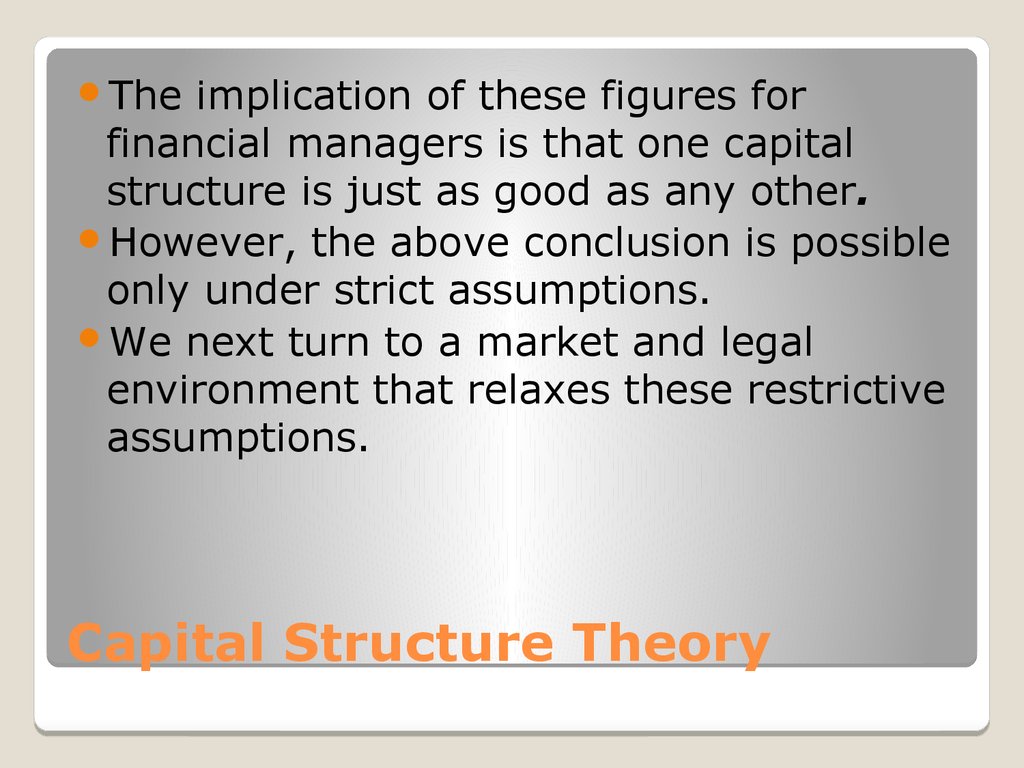
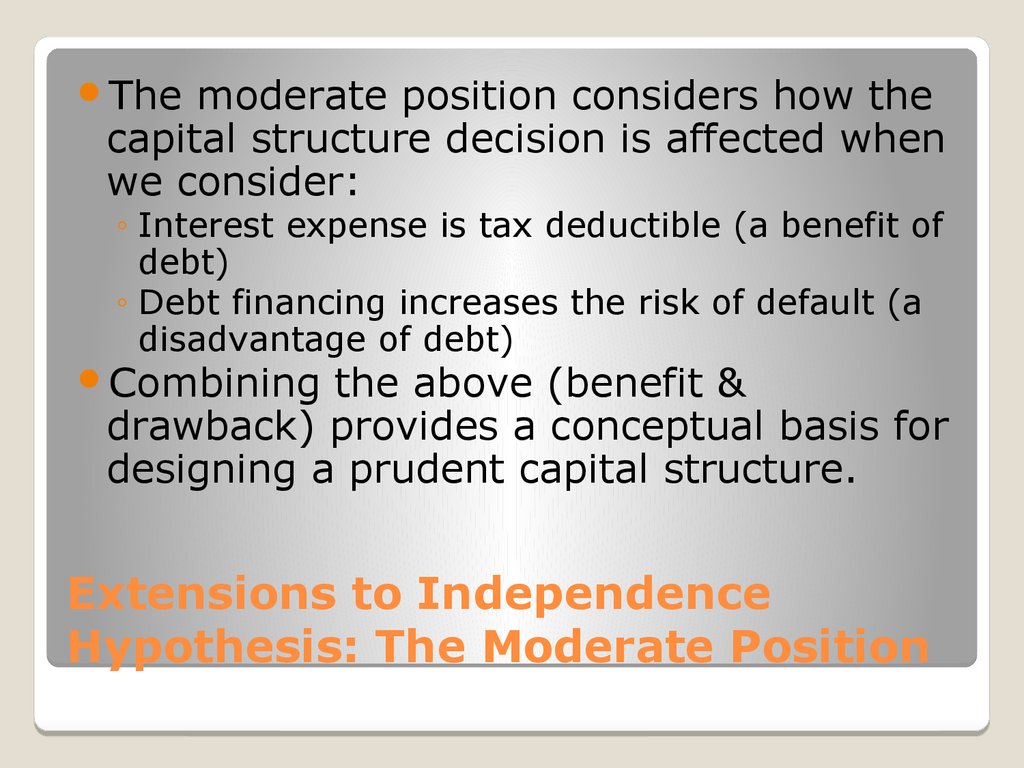




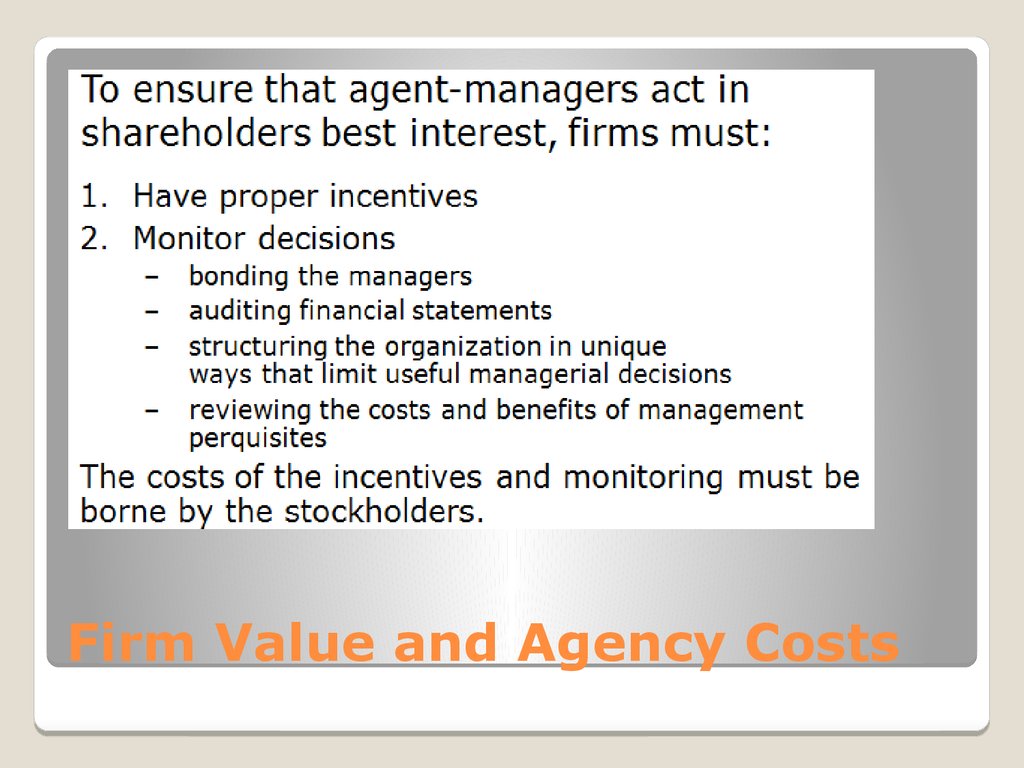
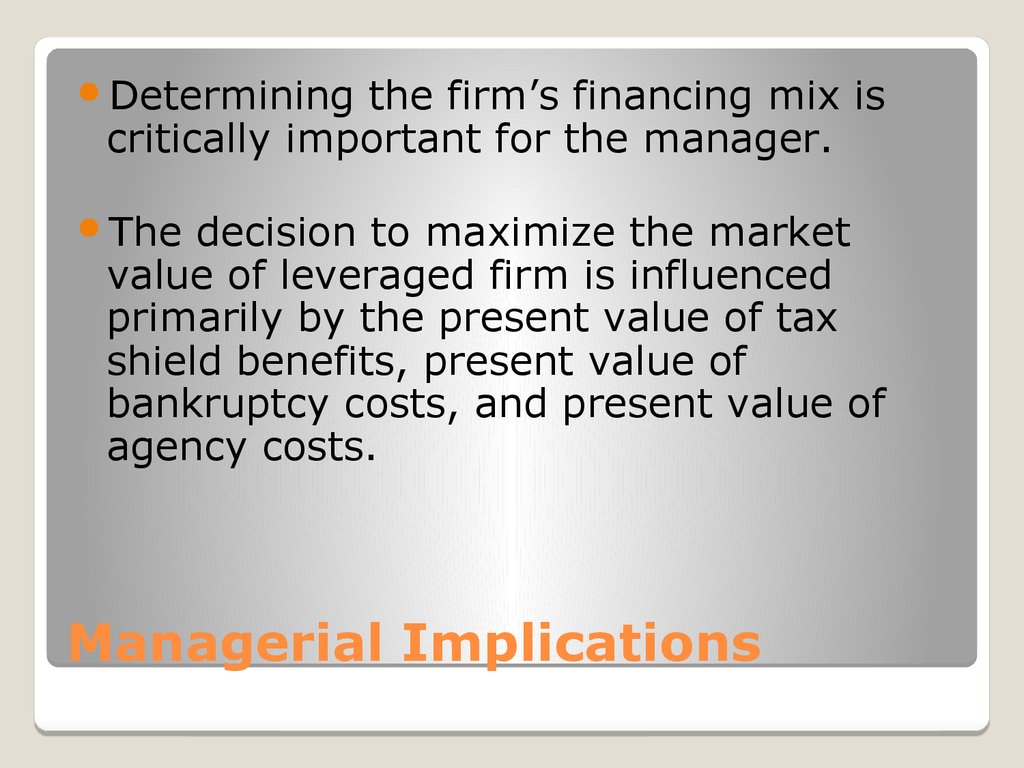

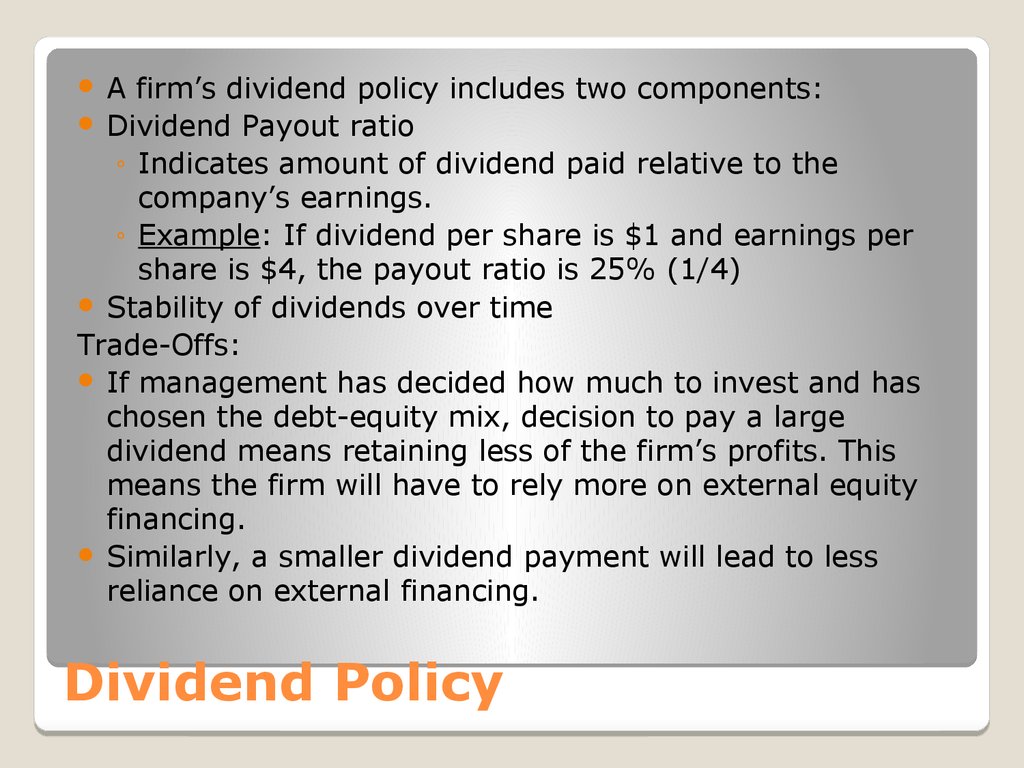
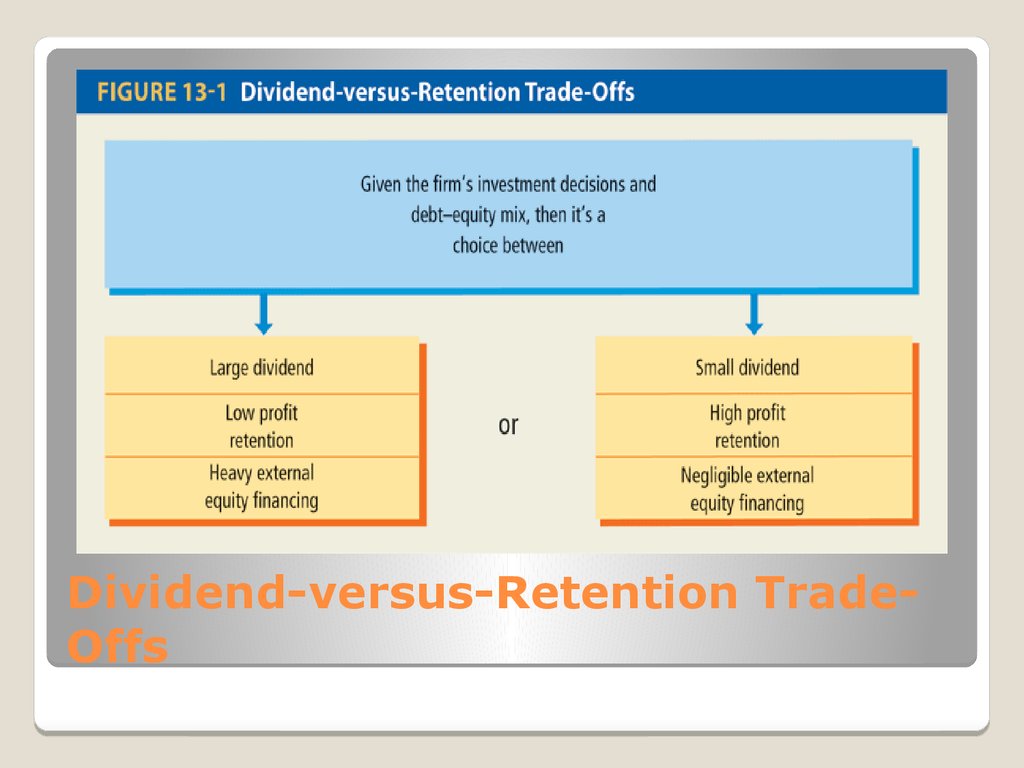
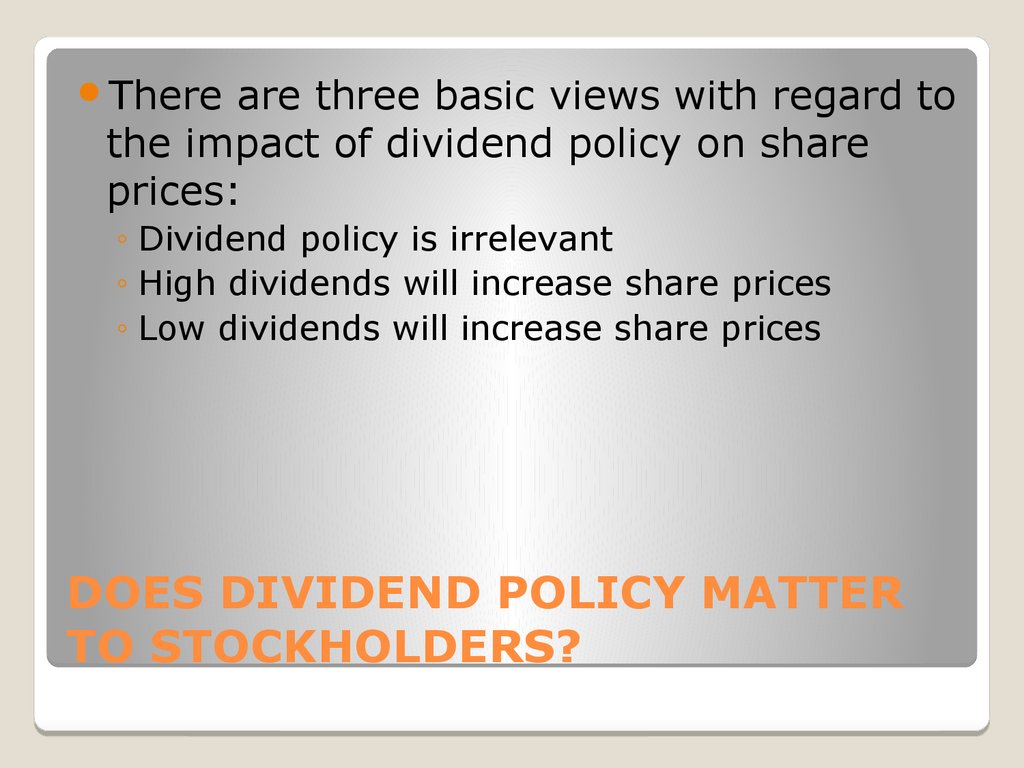
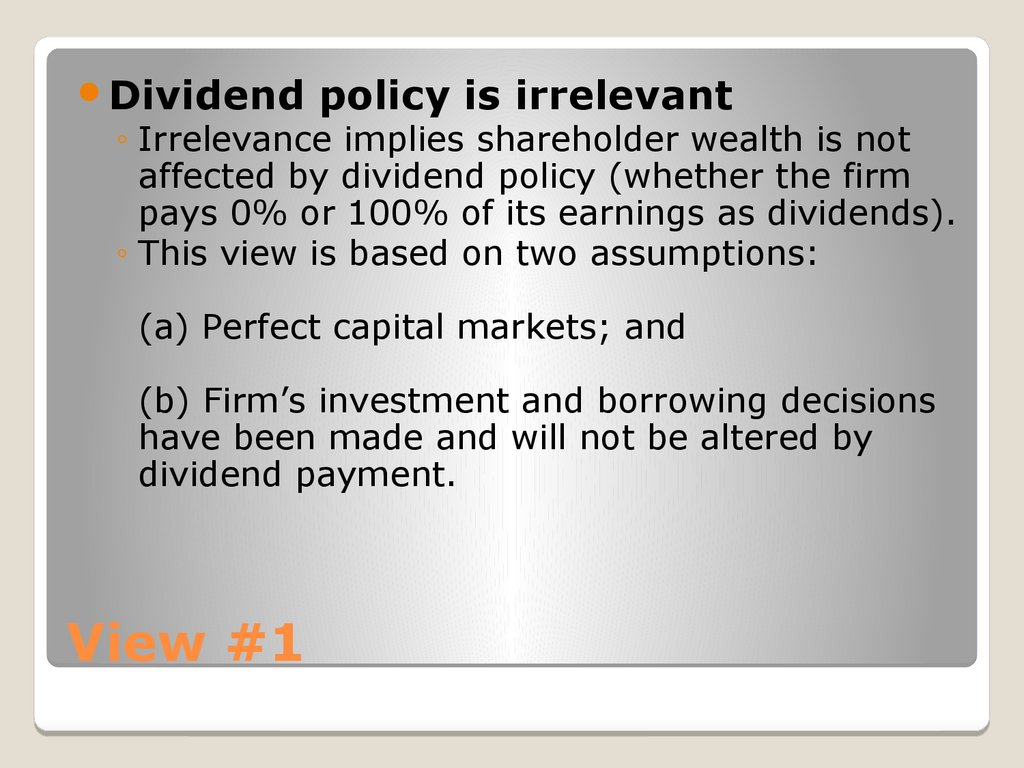

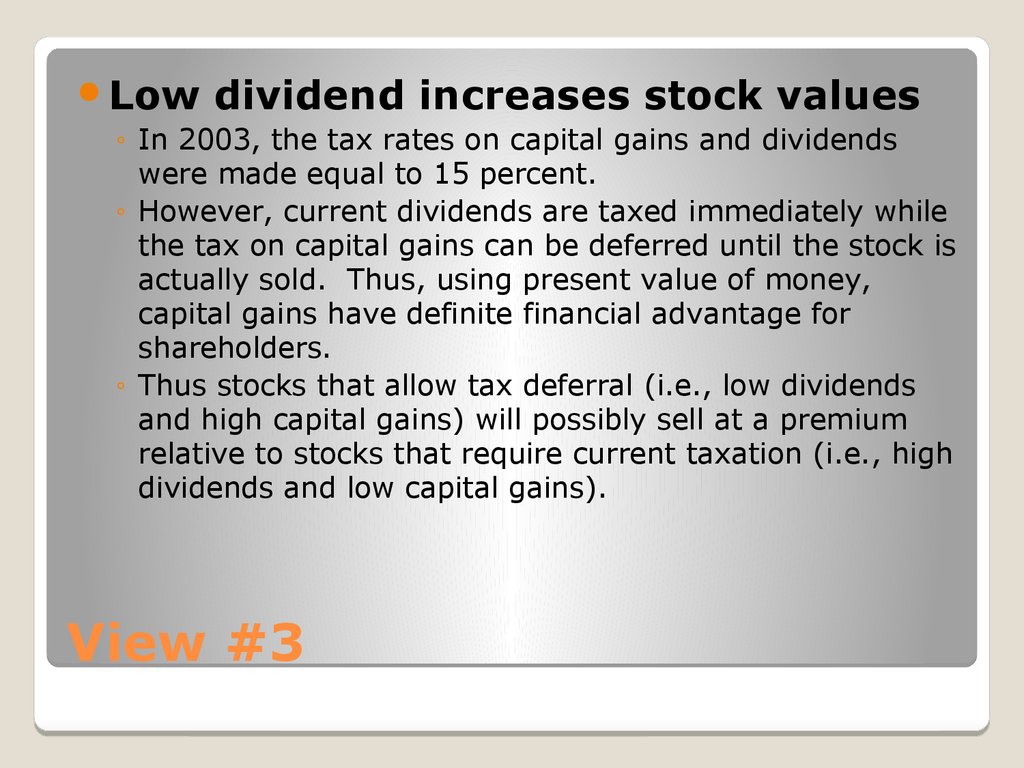

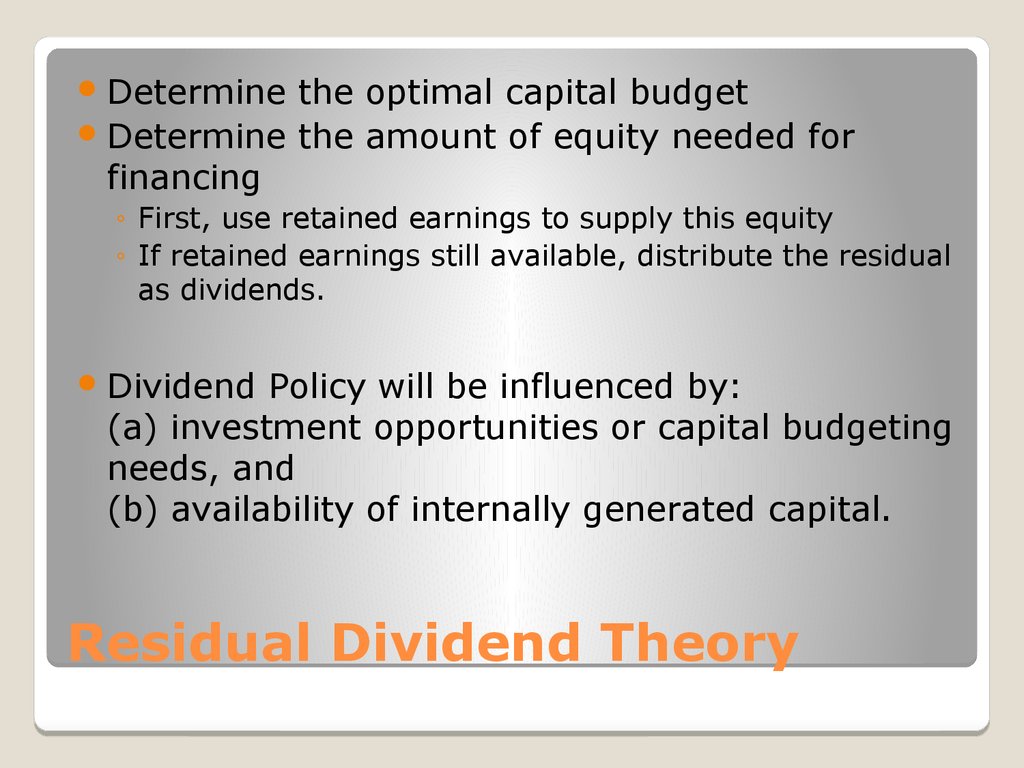

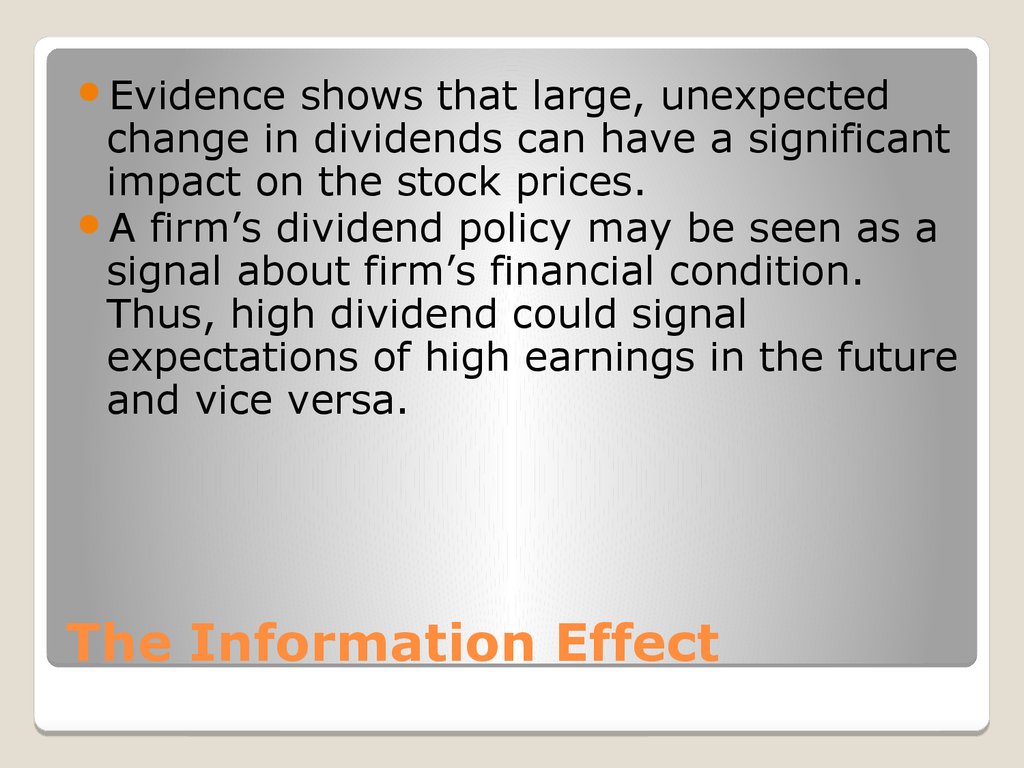

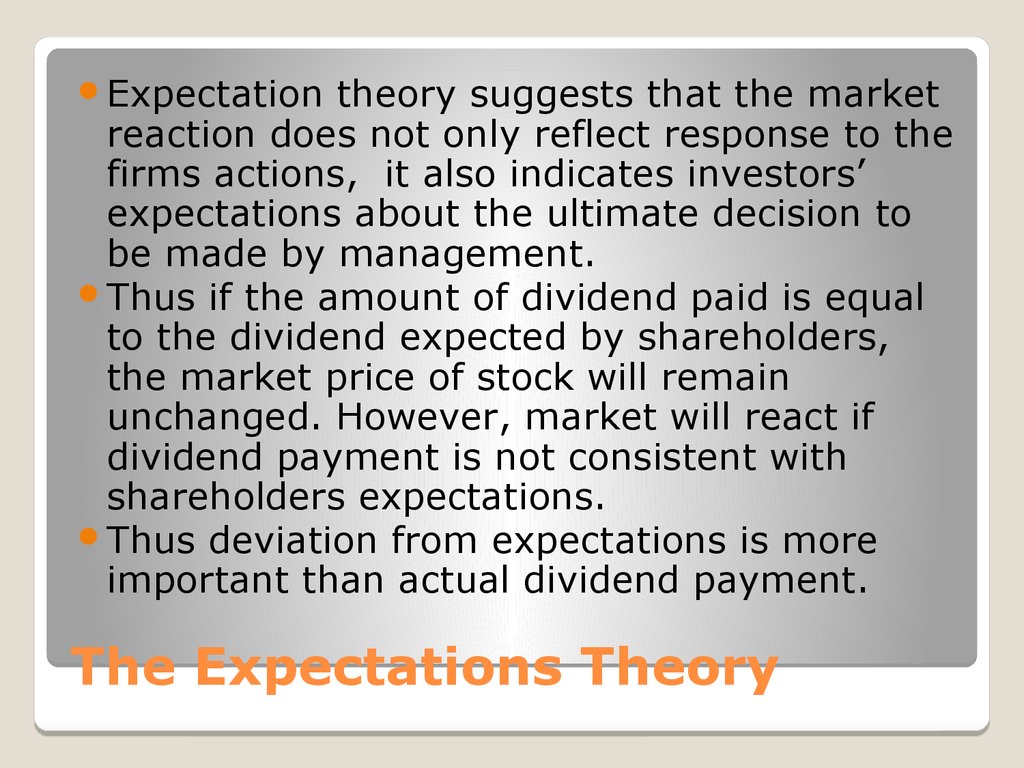

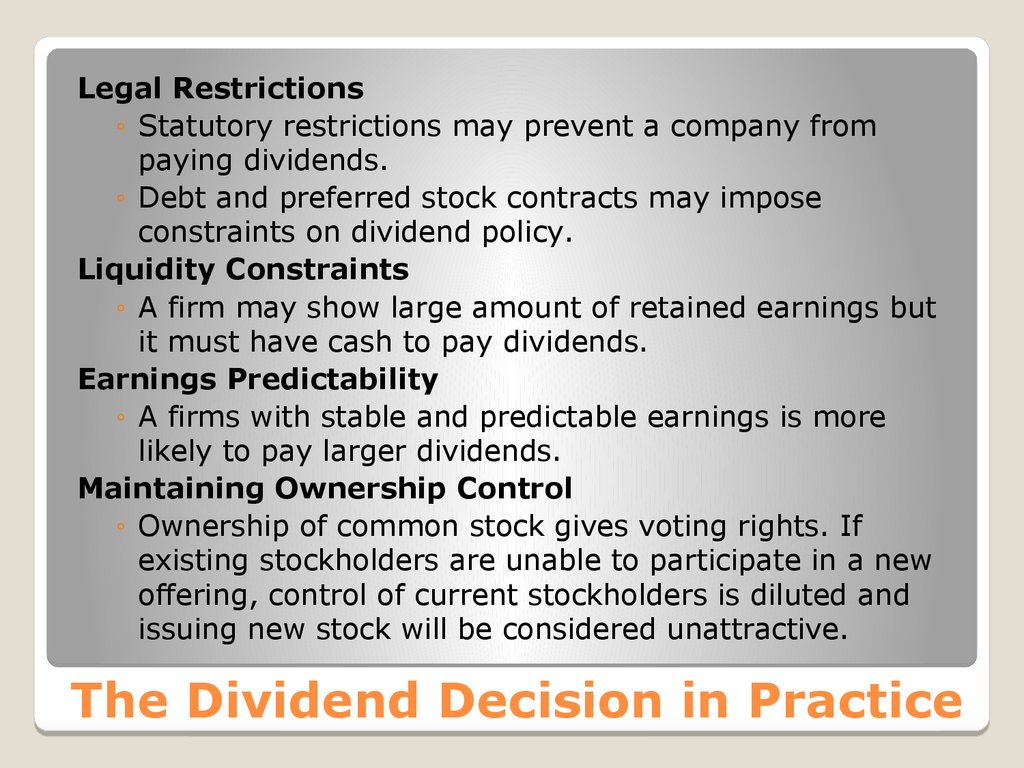


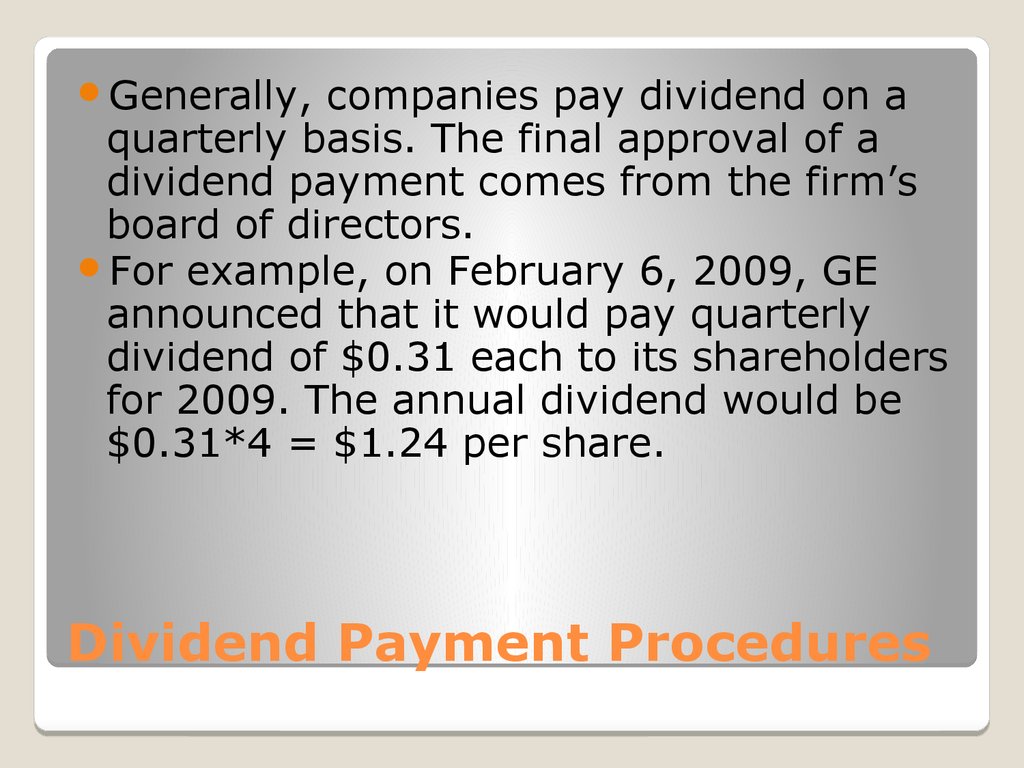
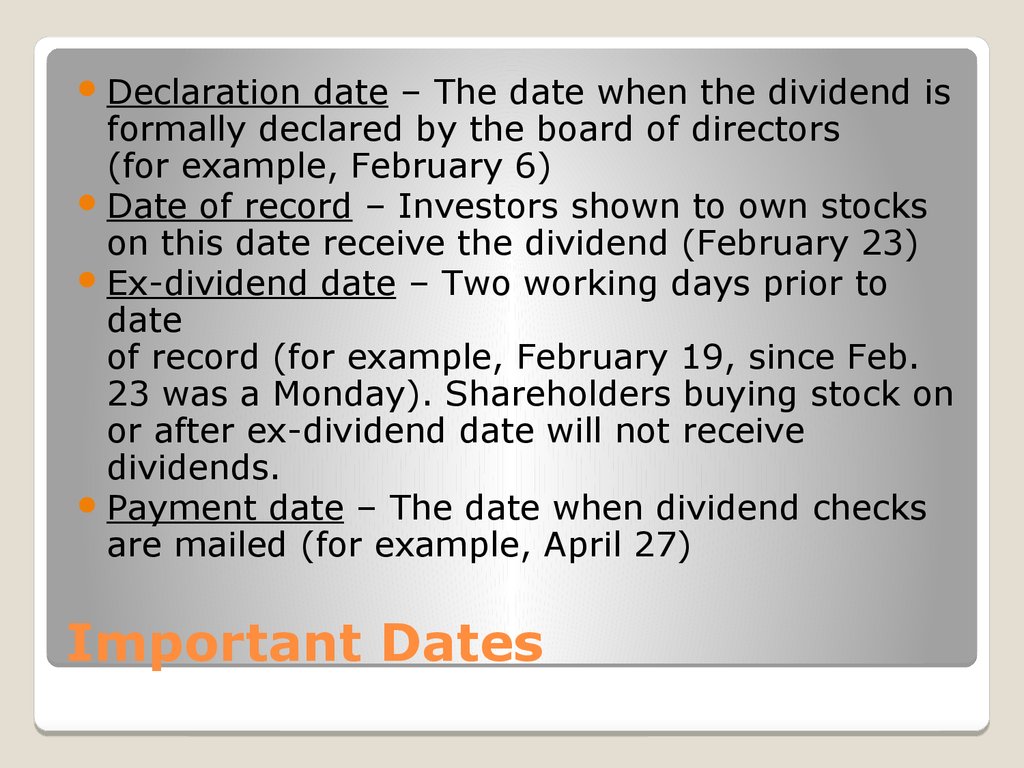

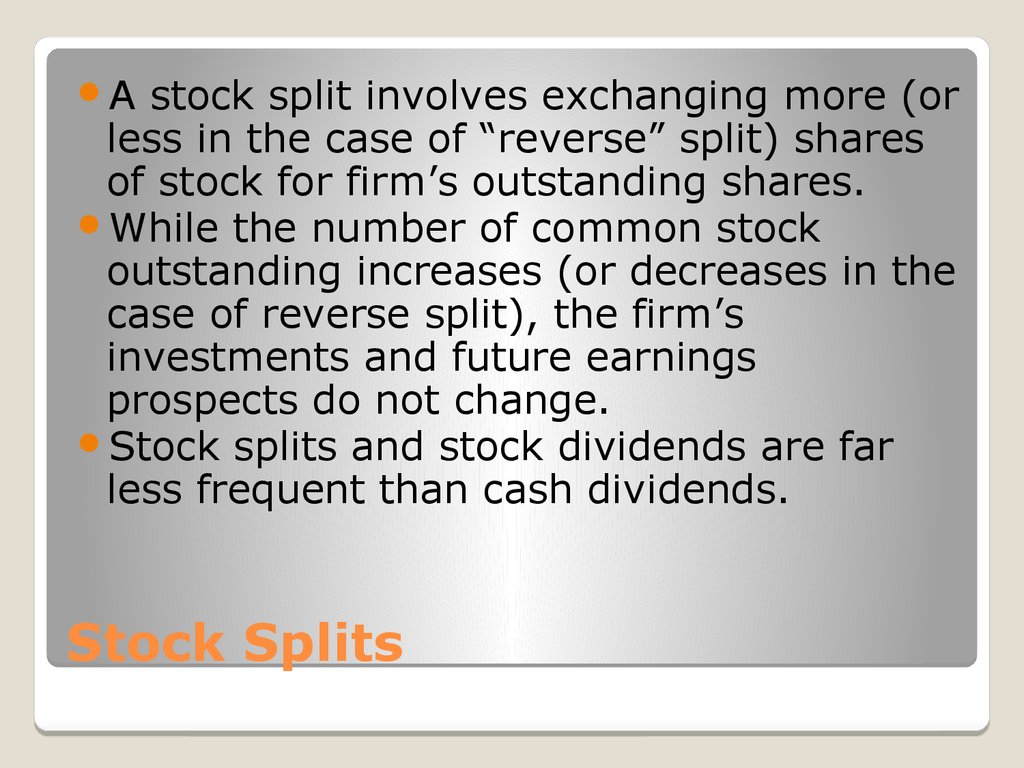
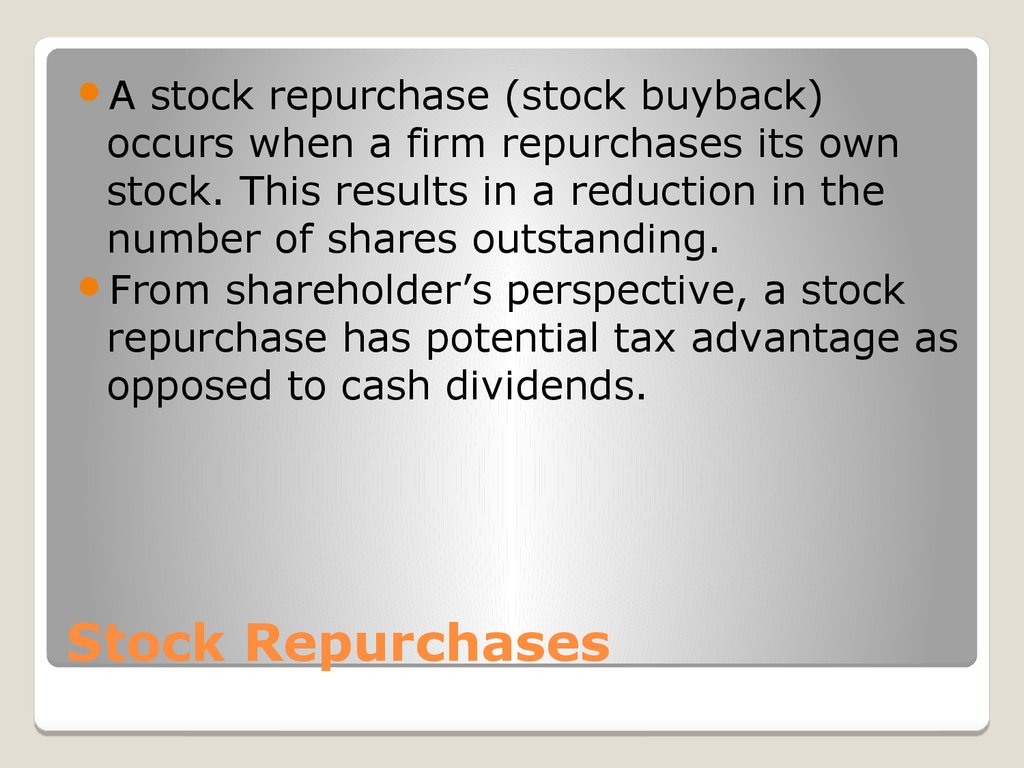

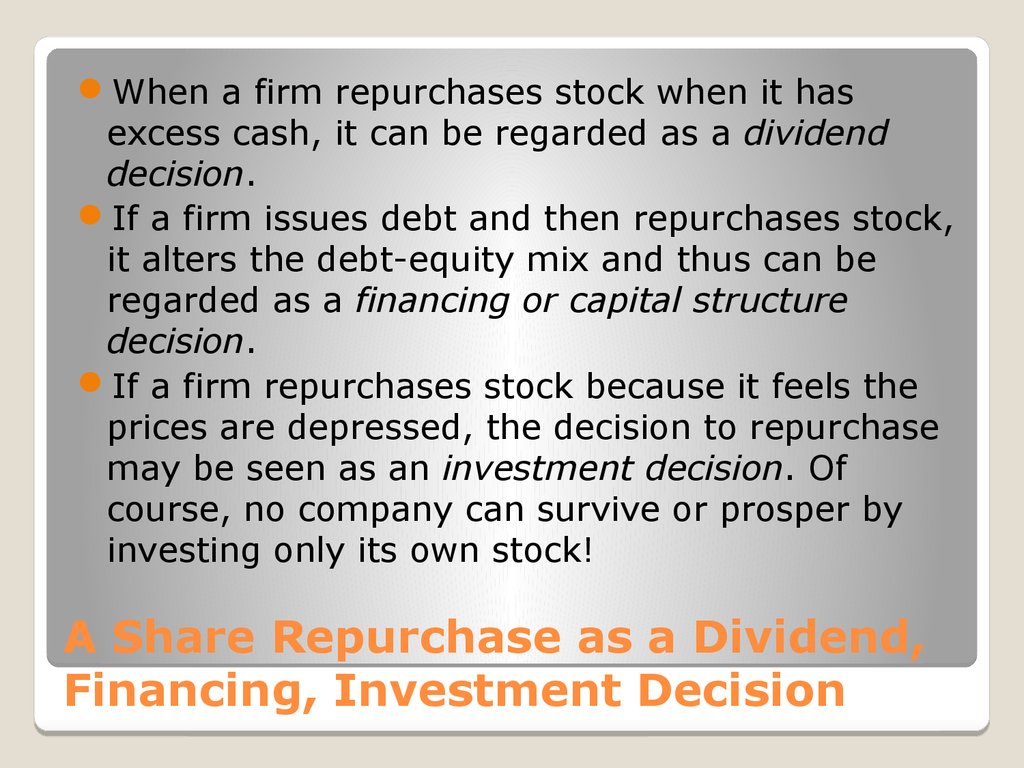
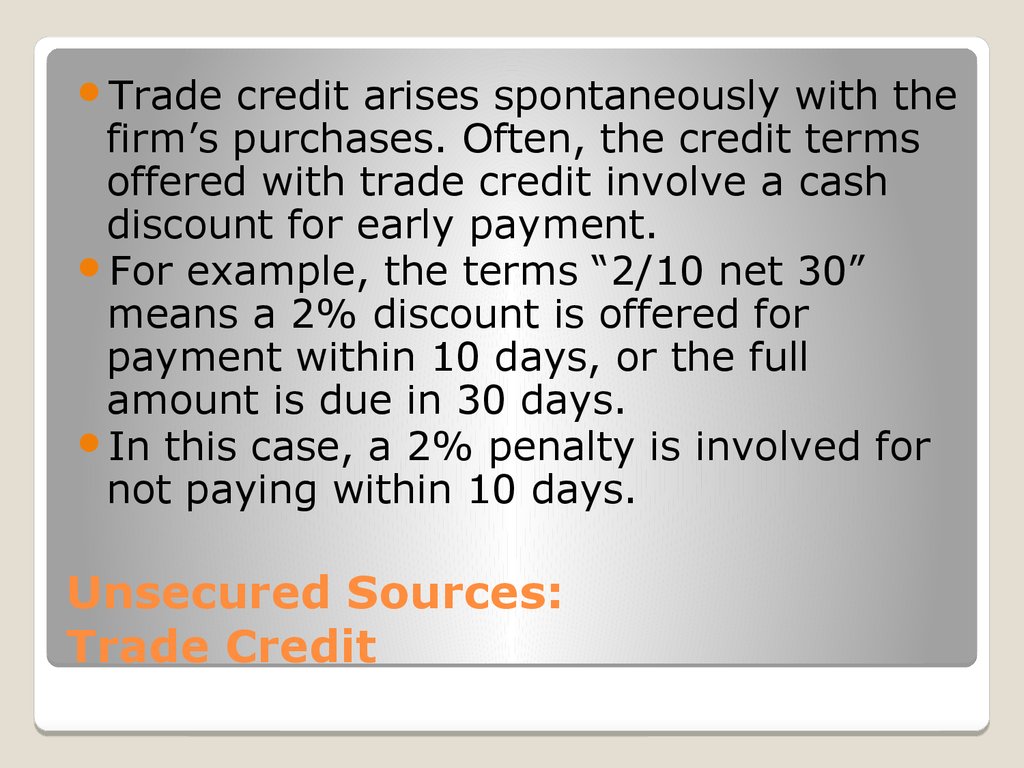

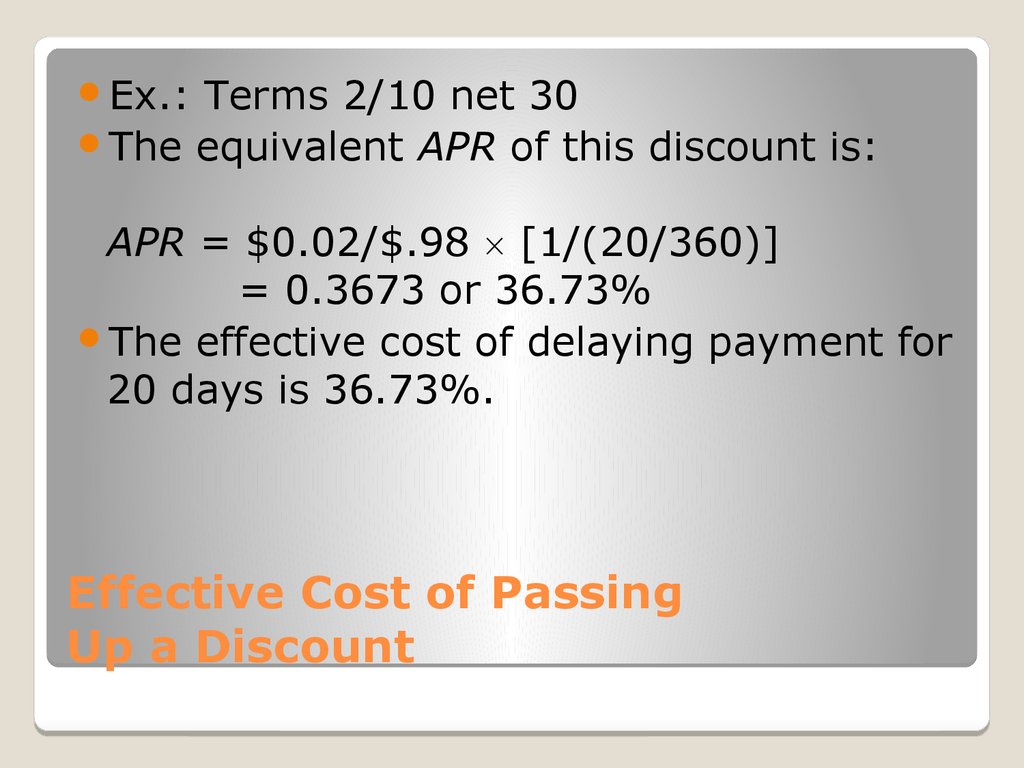
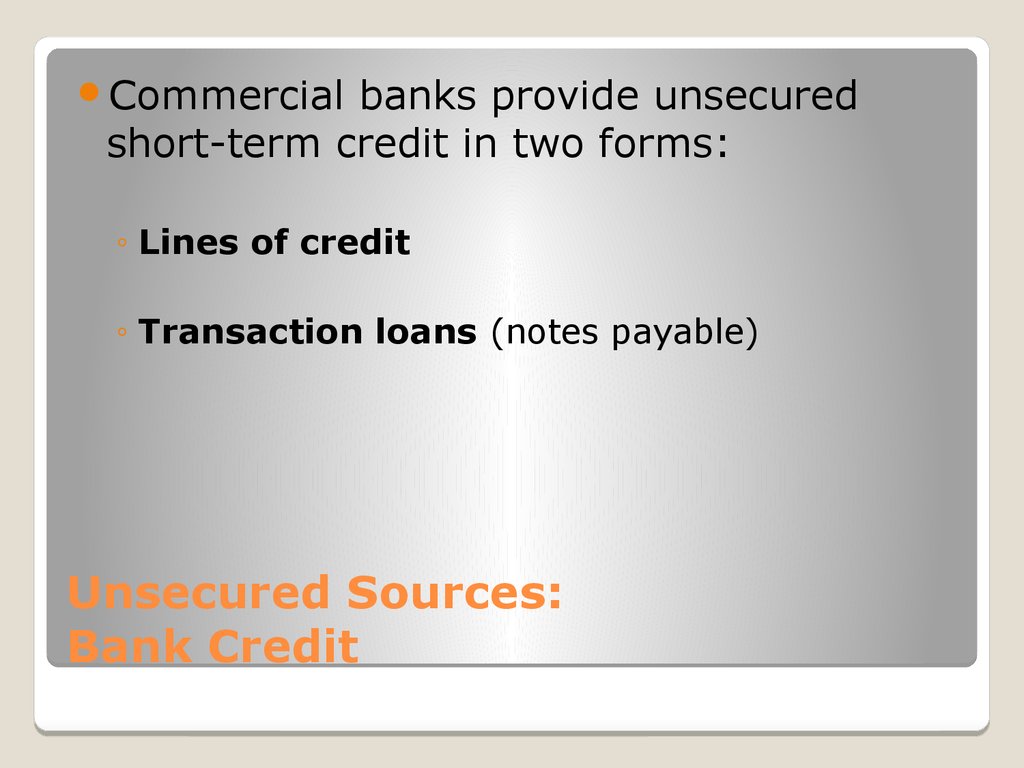

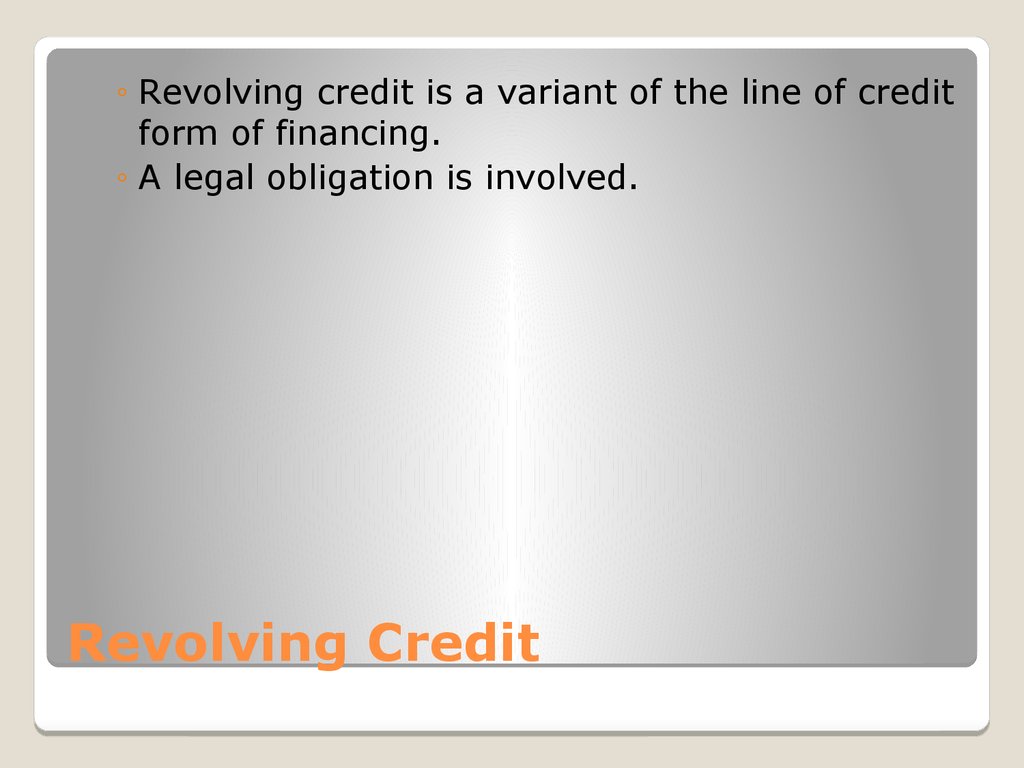



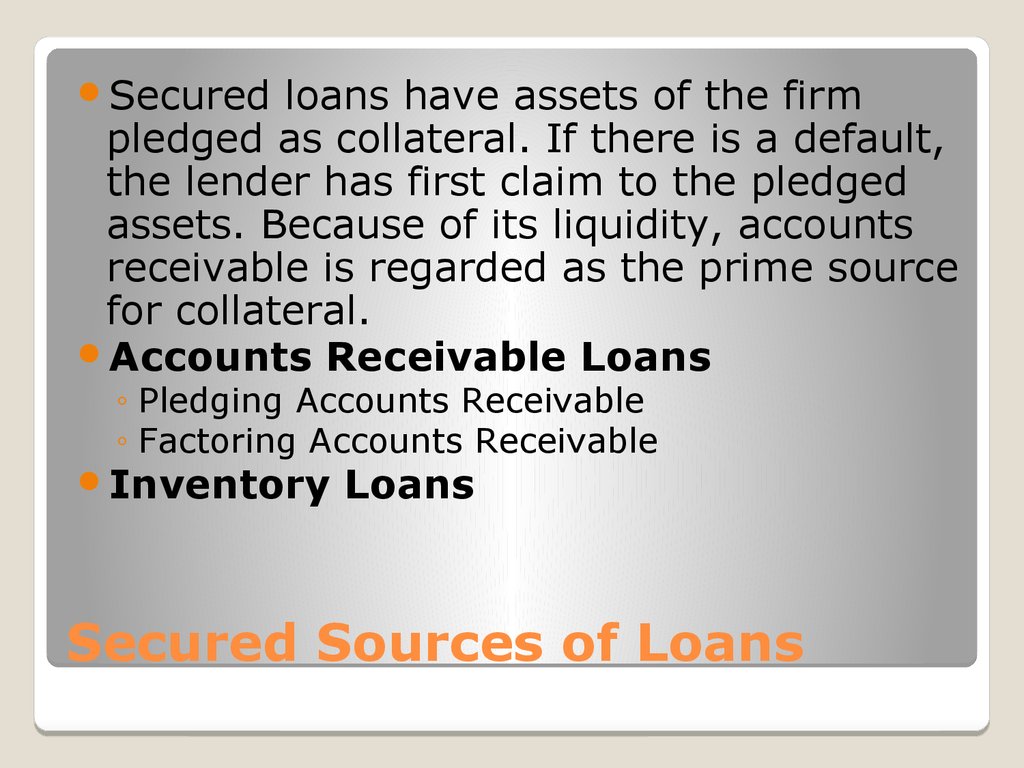
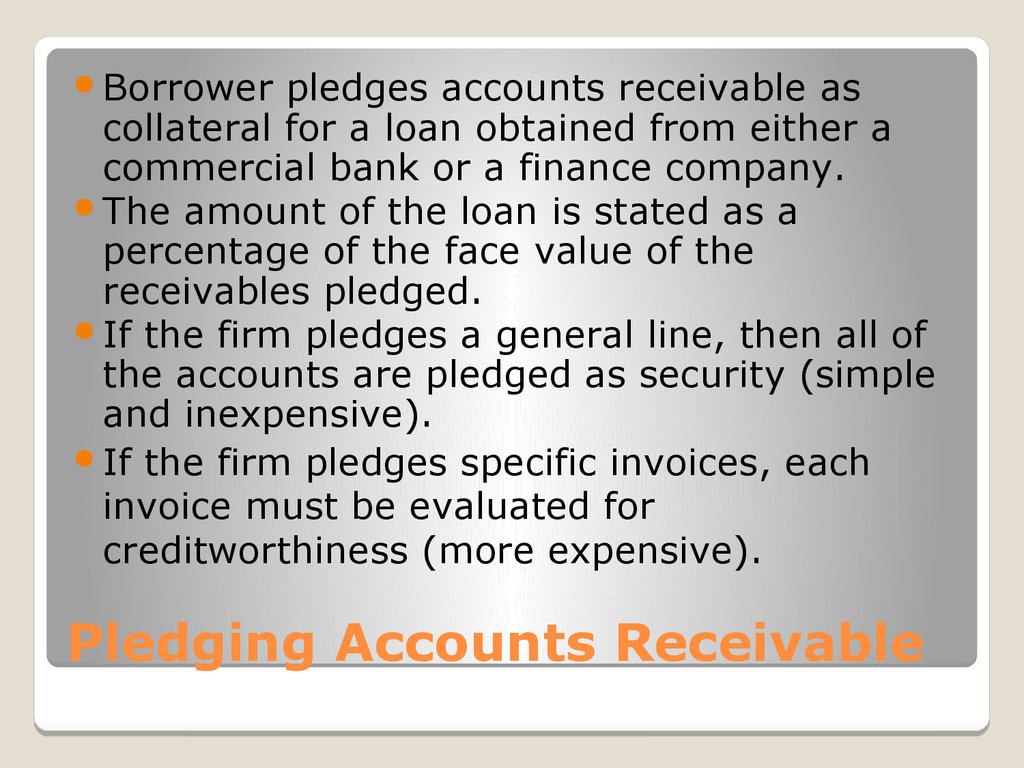

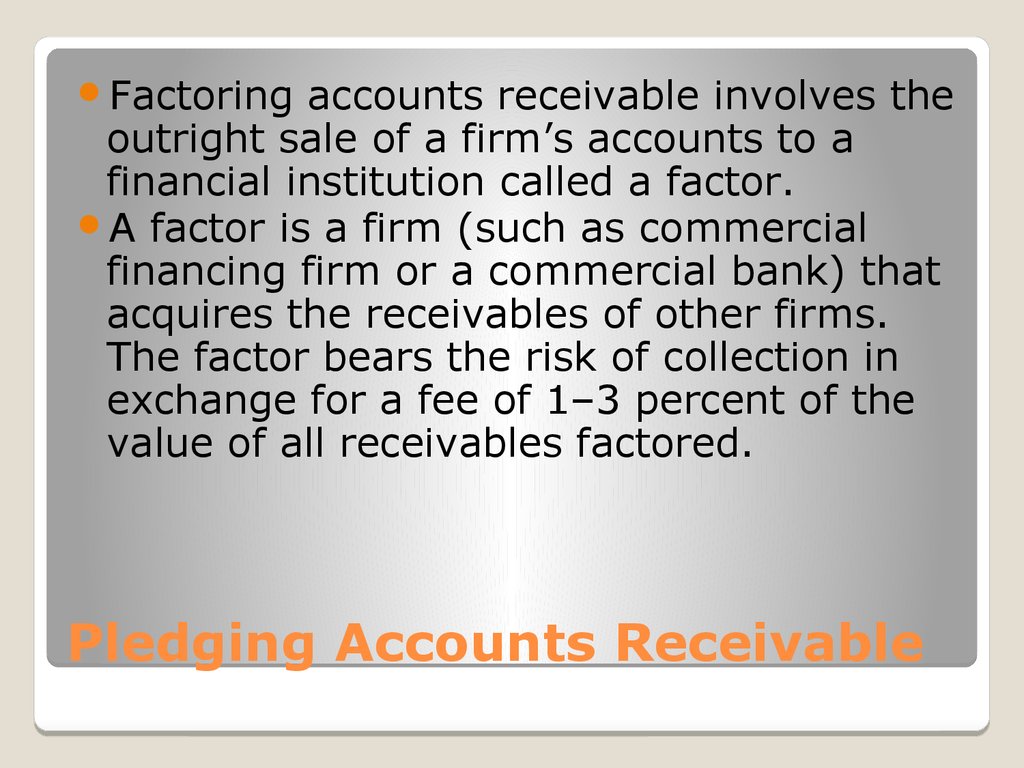
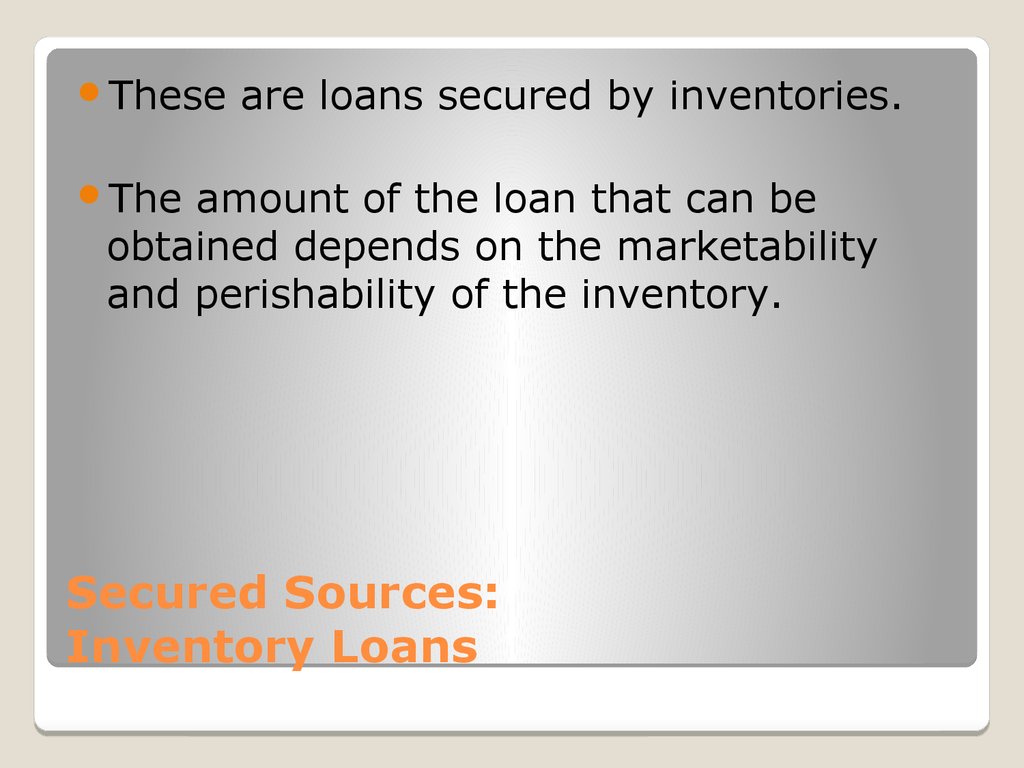
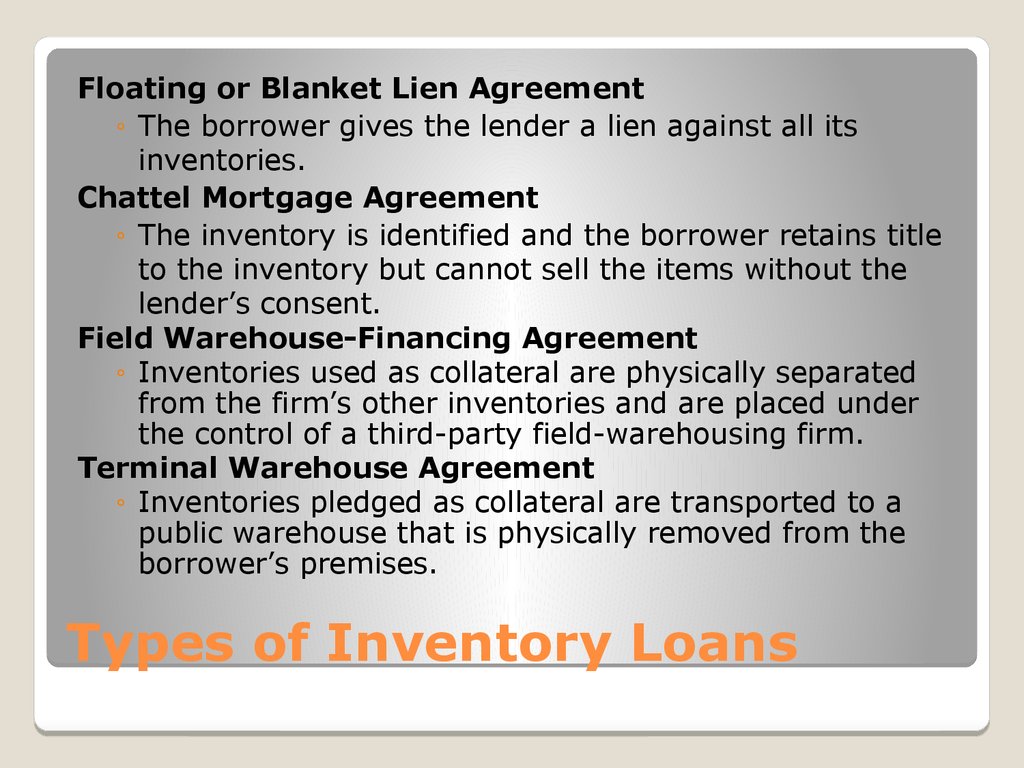
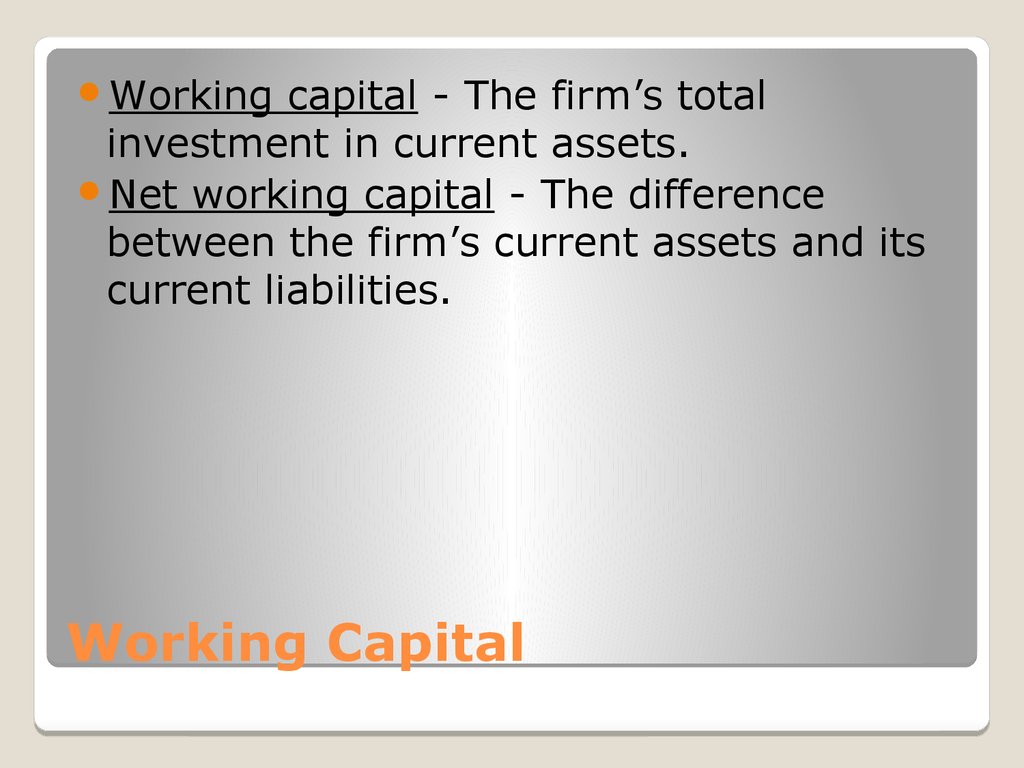



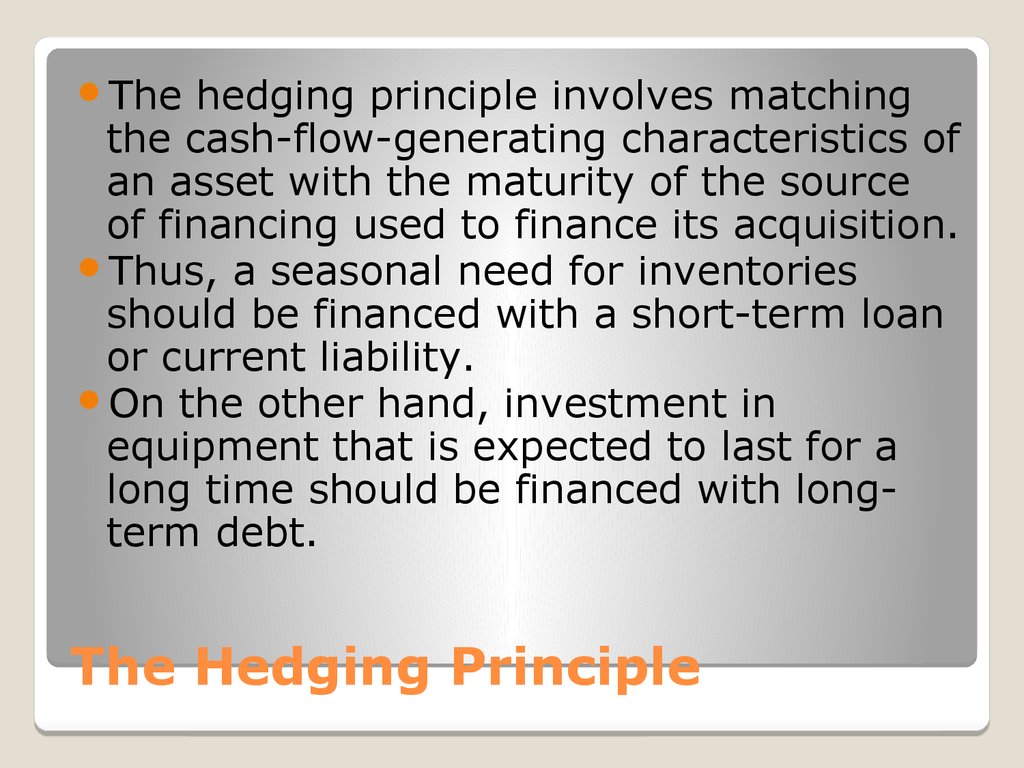

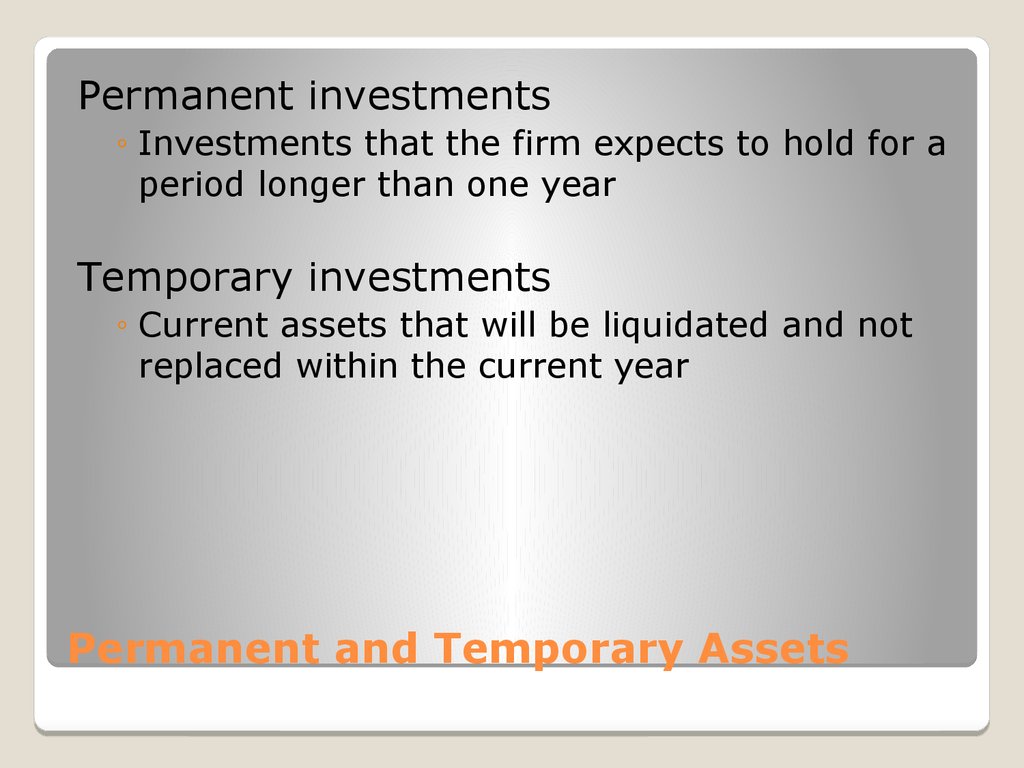

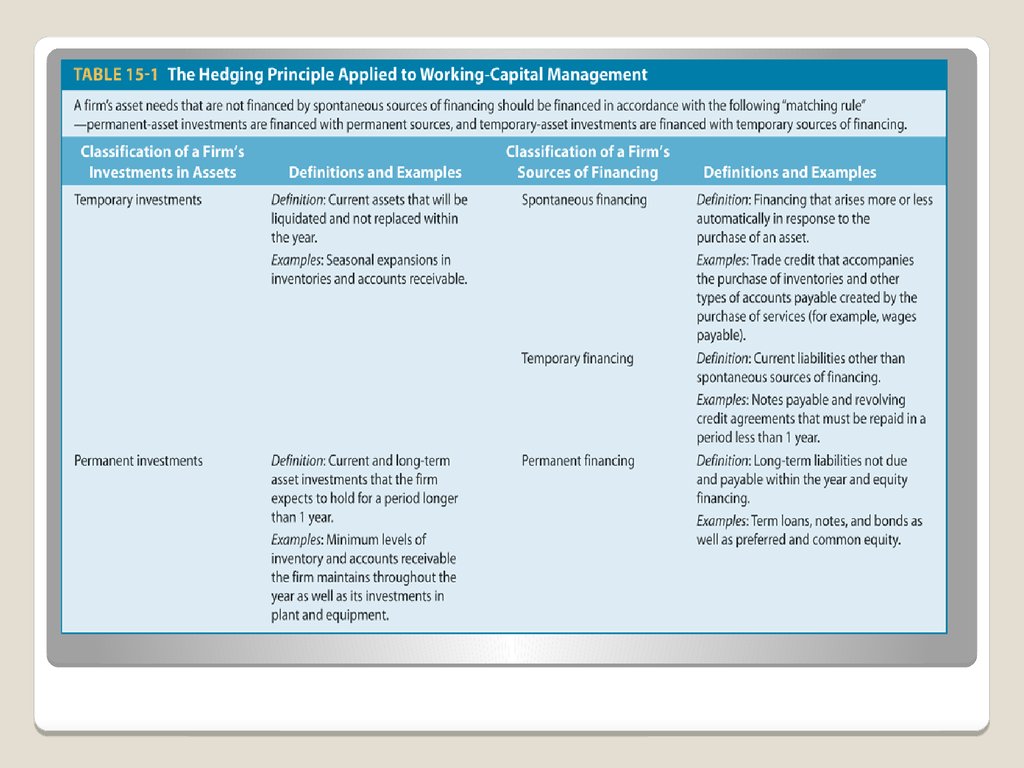
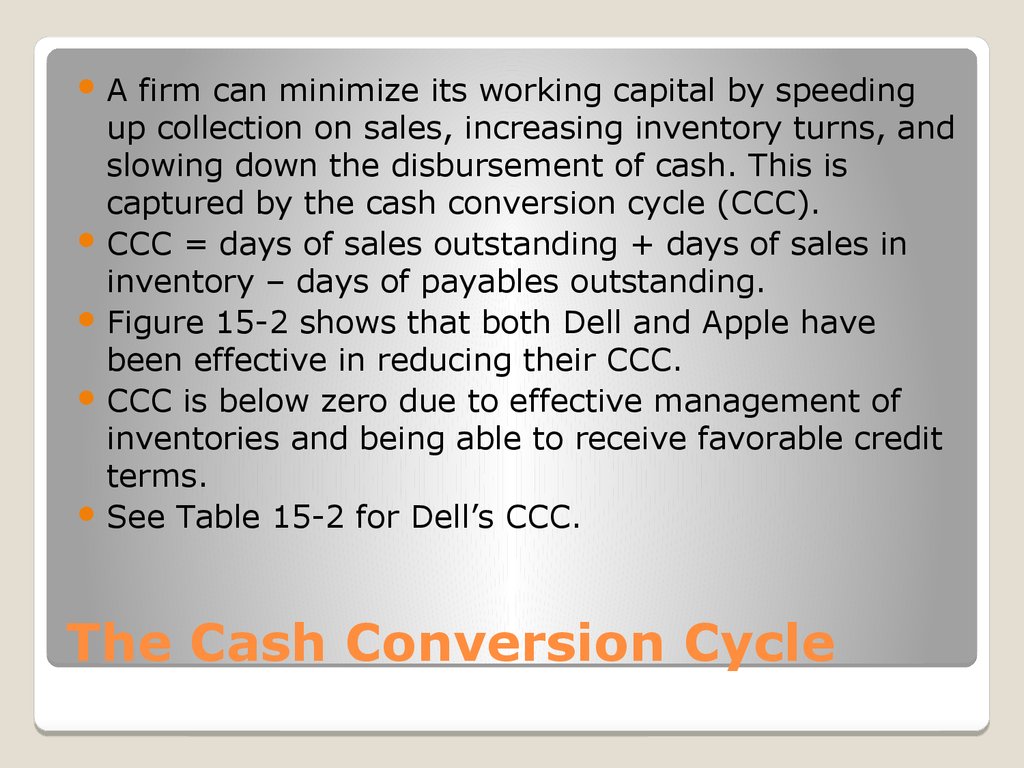
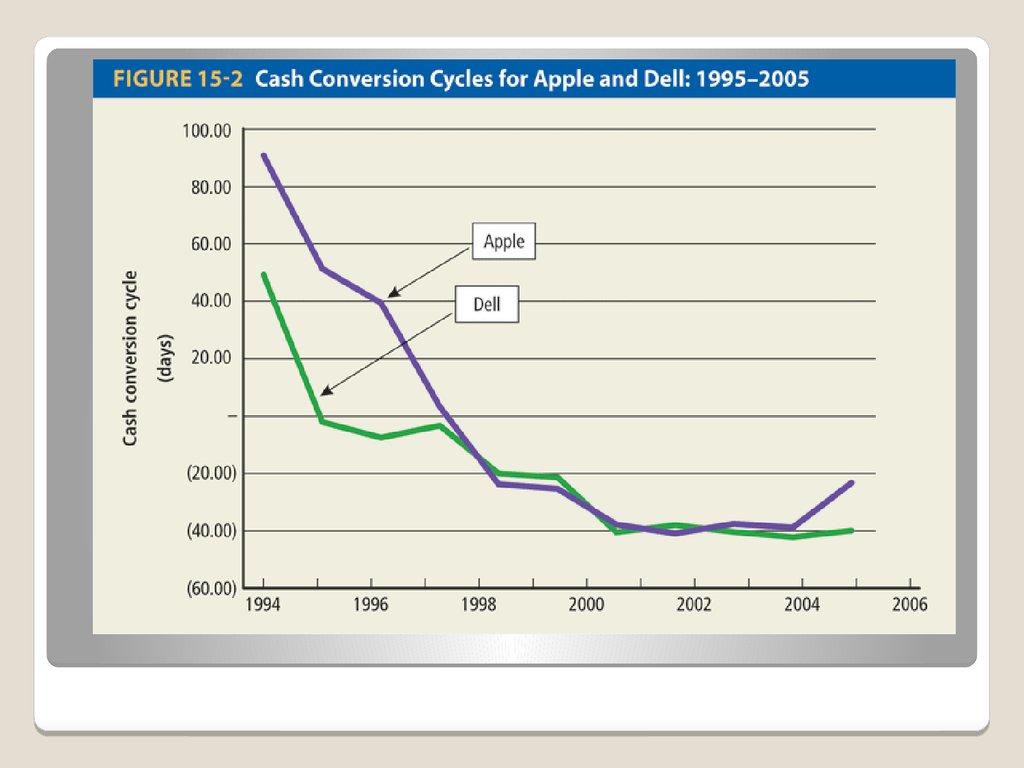
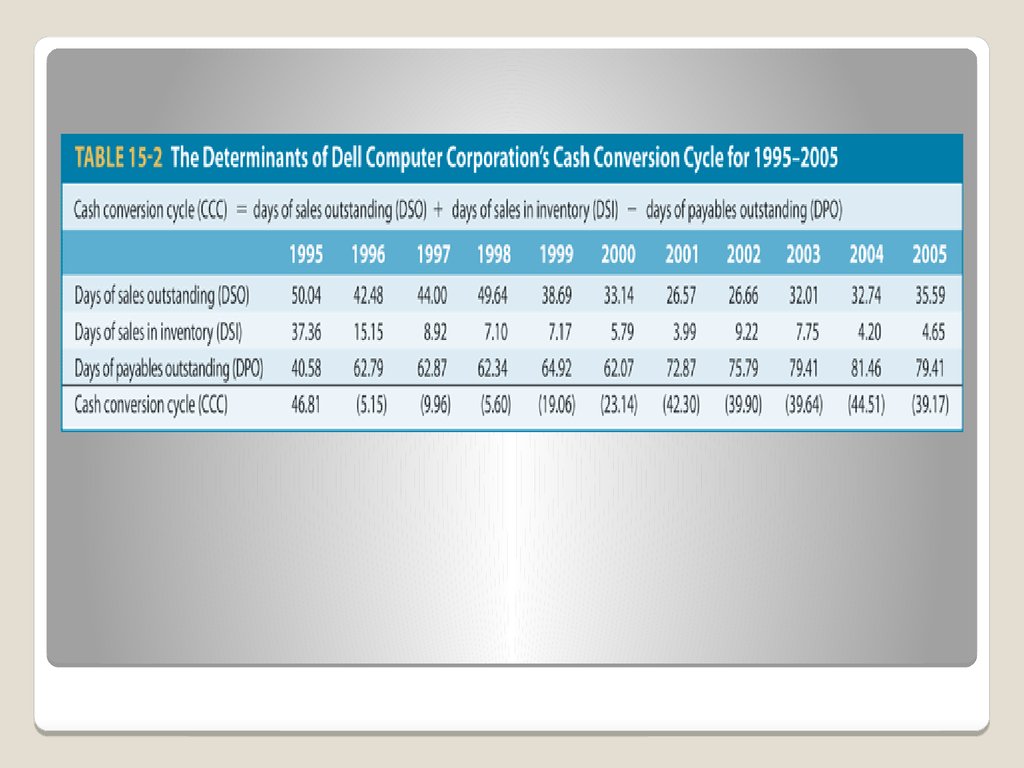
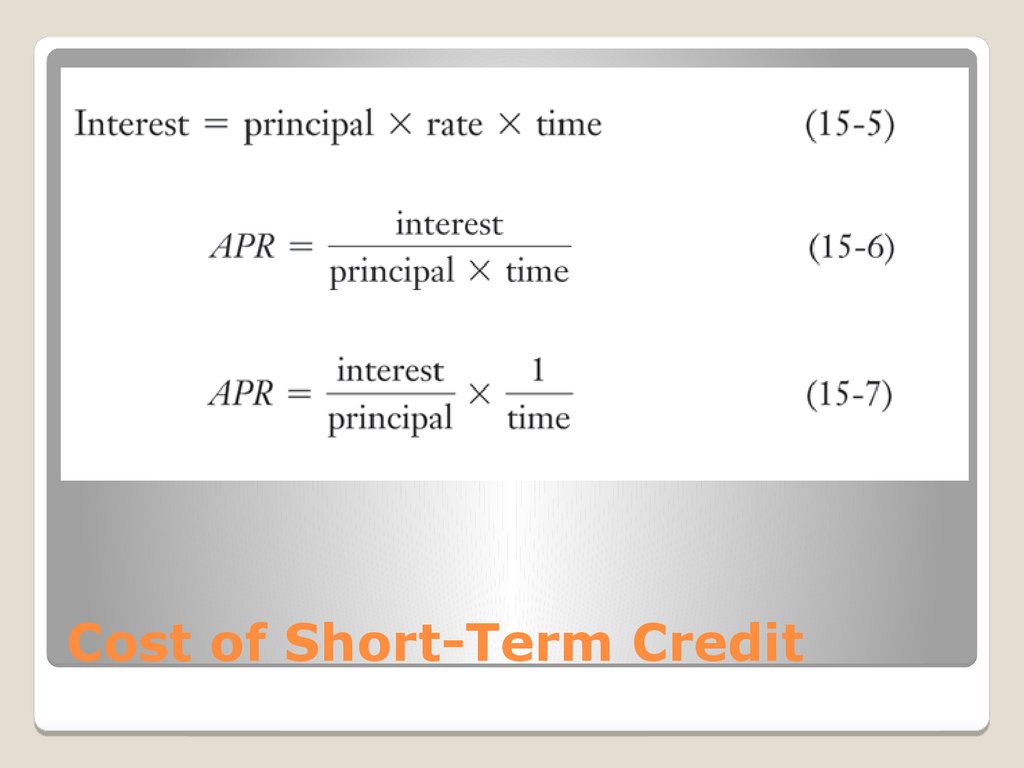
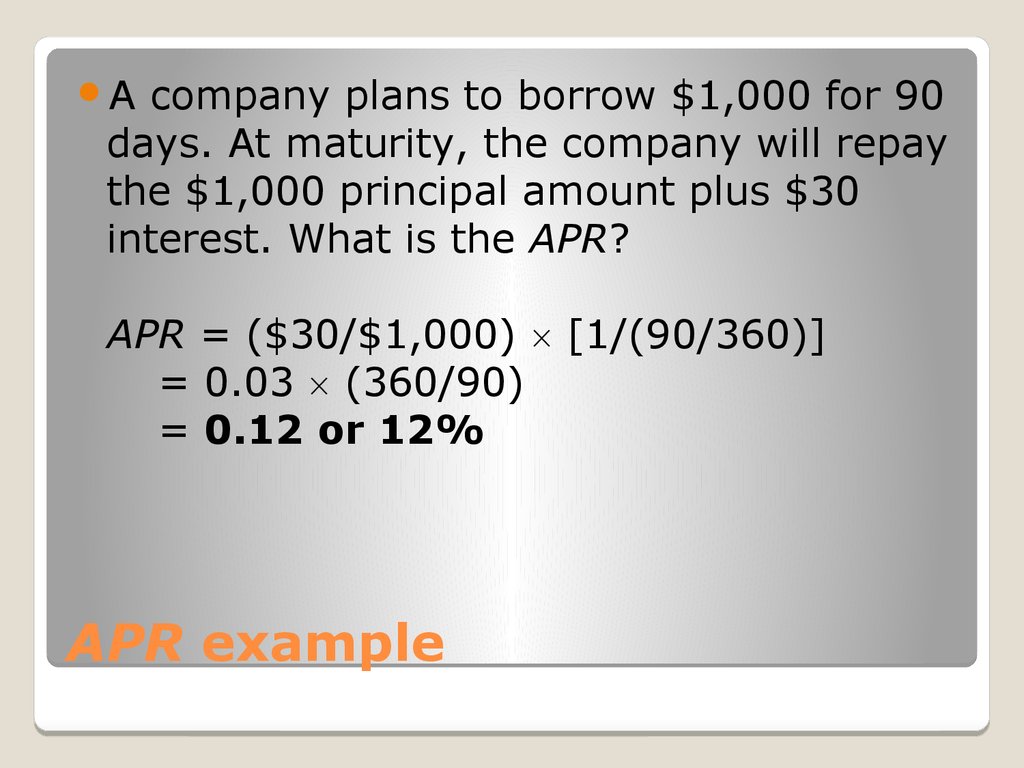
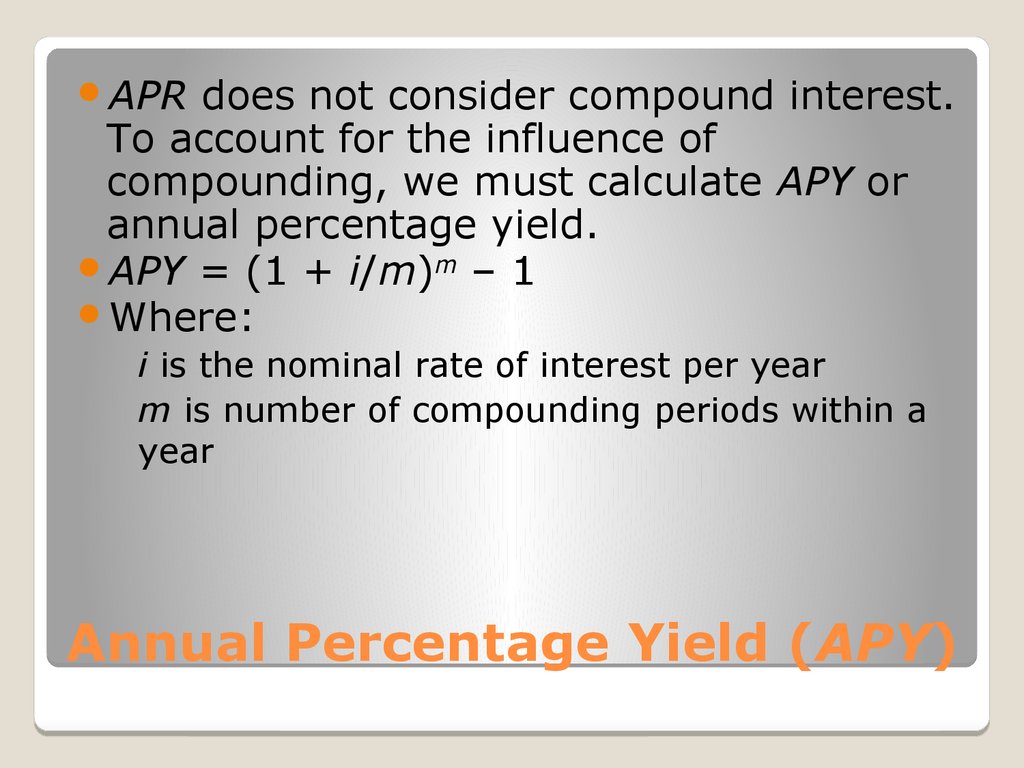
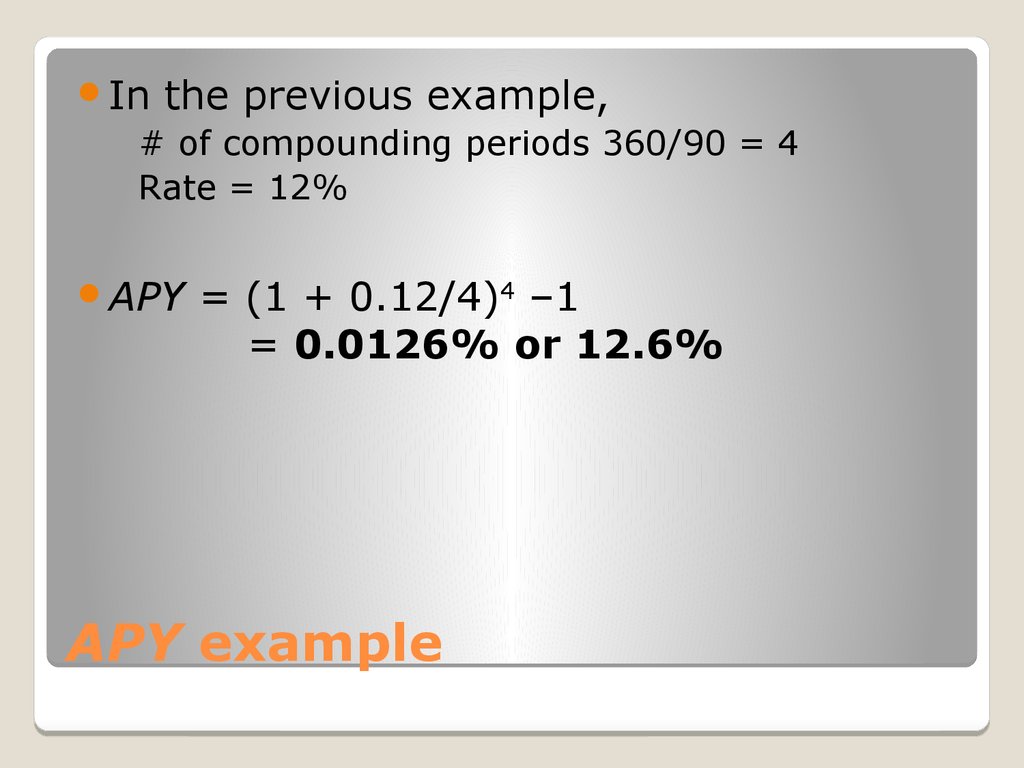
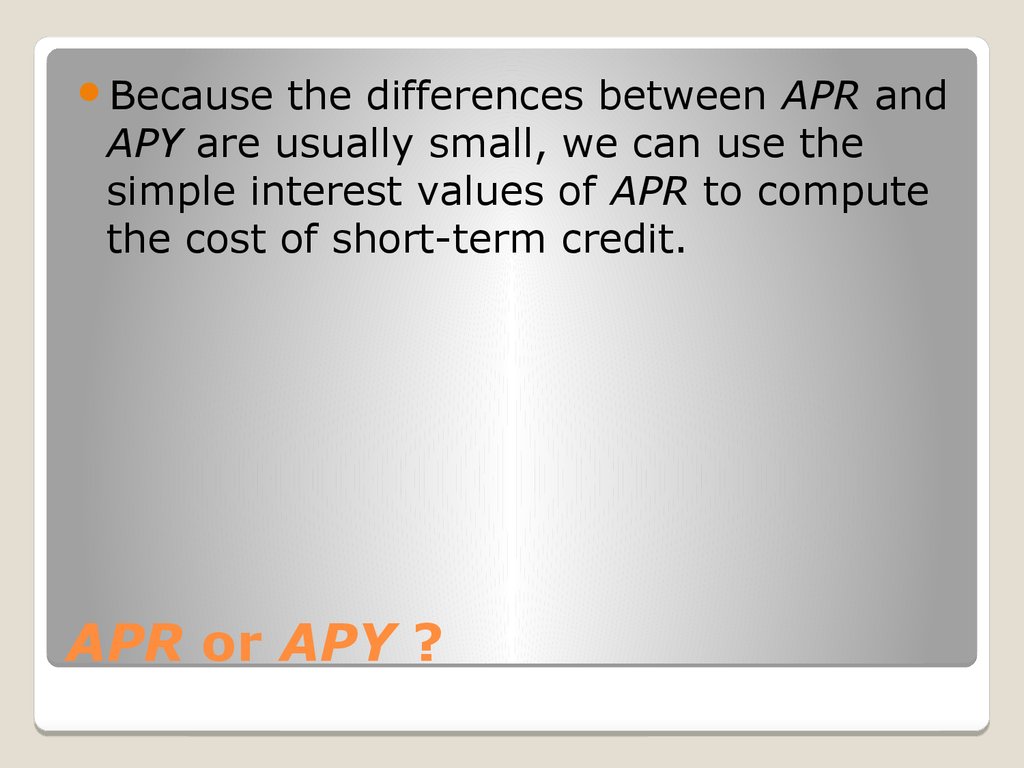
 finance
finance








